- Retour accueil
- Vous êtes ici : Blog The Pyramids of the Cold v2 The Pyramids of the Cold Section 40 • The Smiting Ark of the Covenant
The Pyramids of the Cold Section 40 • The Smiting Ark of the Covenant
Publié par Bruno Coursol dans The Pyramids of the Cold v2 le 25/06/2023 à 11:54

The famous scene of Joshua, "passing through the Jordan river with the Ark of the Covenant", should rather be described as Joshua, following the passing of the Ark through the waters of the Jordan river. The Ark of the Covenant is only a reinterpretation of the operation of the wooden and stone composite impactor of the Great Pyramid of Egypt: the Ark of the Covenant is indeed of a composite design, as it is a chest made of wood, which contains the Tablets of Stone, with the Ten commandments written on it.
Assembled together, these two "Tablets of Stone" are forming a perfect cube: one single block of stone, with 50 centimeters-wide sides.
The Pyramids of the Cold v2 (May-June 2023) • Epilogue Part One
Section 40 • The Smiting Ark of the Covenant
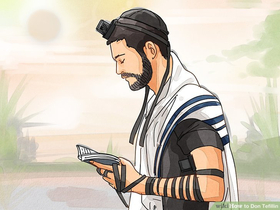
Introduction: we've already seen in this study that the ancient Egyptian religion, as the glorification of scientific and technological accomplishments, literally triggered many deities and myths in foreign countries all over the ancient World: it's what happened with the Hindu mythology (the Churning of the waters of the Ocean of Milk…), the Tibetan prayer wheels, the Maoris' ceremonial dance Haka and the Norse mythology (the magical Hammer of Thor…); so if the impact of the Great Pyramid on the ancient World has been so strong abroad Egypt, why wouldn't have it been strong enough to trigger such reinterpretations in Egypt itself, even after the Pharaonic era ended?
This is a major question, the kind of question which can completely transform this study, by bringing the ancient Egyptian accomplishments and self-glorifications right into our very present: we are still worshiping the Great Pyramid today.
Of course, every single heart symbol that we are constantly exposed to in our modern societies, is directly referring to the inclined well of the Great Pyramid: the well functioned just like a beating heart and the endless penetrating movement of the impactor both inside the well and the hauling Beetle, covered its operation with a full layer of possible sexual intercourse and love metaphors.
But this is nothing compared to the real impact that the Pyramid still have today in probably every country in the world: the three monotheistic religions, Judaism, Christianity and Islam, are all together originating in the Great Pyramid.
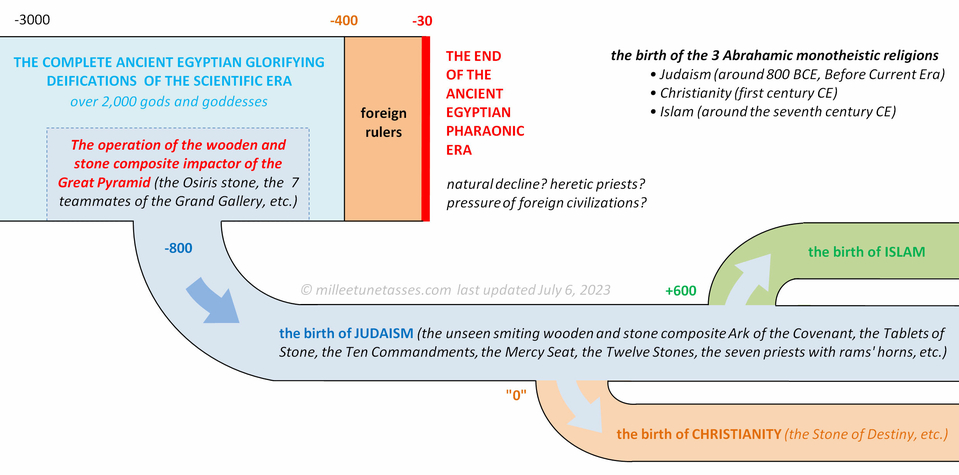
"The Abrahamic religions are a group of religions centered around the worship of the God of Abraham. Abraham, a Hebrew patriarch, is extensively mentioned throughout the Abrahamic religious scriptures of the Quran, Hebrew, and Christian Bible. […] In the 1st century CE, Christianity emerged as a splinter movement out of Judaism in the Land of Israel, developed under the Apostles of Jesus of Nazareth; it spread widely after it was adopted by the Roman Empire as a state religion in the 4th century CE. In the 7th century CE, Islam was founded by Muhammad in the Arabian Peninsula; it spread widely through the early Muslim conquests, shortly after his death." https://en.wikipedia.org/wiki/Abrahamic_religions
Probably at the end, or near the end of the pharaonic Era, ancient Egyptians understood their polytheistic religion with more than 2,000 gods and goddesses wouldn't survive the pressure that foreign civilizations were applying on Egypt; and as a matter of assuring some kind of survival of the ancient glorifications created by their ancestors, Egyptians forged a brand new monotheistic religion in which they could have transferred the original deifications: this is how Judaism was born, around 800 BCE; and from Judaism, emerged Christianity (around 100 CE) and finally Islam, the youngest of the three modern monotheistic religions (around 600 CE).
What these three religions have in common is certainly vast, but the most important similarity is probably the prophet Moses, who just like the ancient Egyptian god Osiris, had been saved from the waters of the Nile: when Osiris had been tricked into a wooden coffin and thrown into the waters of the Nile, before being saved by Isis, Moses as a child had been released into that same waters, into a floating basket, before being saved from these waters by the pharaoh's daughter (that is the "Finding of Moses).
Moses and Osiris are actually referring to the exact same thing: the impactor of the Great Pyramid, and just like ancient Egyptians used to represent the same thing twice in a same representation (Osiris standing on the Osiris stone, Bes standing on the Bes wedging block, etc.), they also did the exact same thing with Moses: when Moses is holding the Tablets of Stone, Moses actually is entirely about these stones.
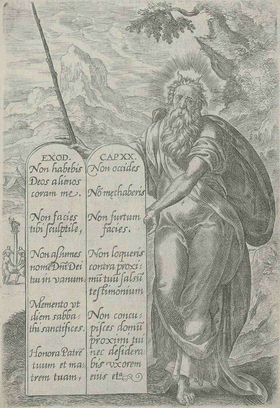
The key to understand the 3 Abrahamic religions actually lies in Moses and in the Ark of the Covenant that god instructed Moses to build to accommodate the two Tablets of Stone on which He carved the Ten Commandments. But we shouldn't be misguided by the numerous artistic representations of these Tablets: they were actually very thick blocks of stone; so thick that according to the Talmud, if you would assemble them together like they were supposed to be inside the Ark, they'd form a perfect cube of stone, with 50 centimeters-wide sides.
That "Moses cube" of stone is the key, because the story of the Finding of Moses, floating in his basket into the waters of the Nile before being saved by the pharaoh's daughter, is the exact same story as the Osiris myth, where Osiris is tricked into a floating coffin and thrown into the waters of the Nile, before being saved by goddess Isis.
In other words, Moses is a reinterpretation of Osiris; and I'm not the first one to come to that conclusion.
I've already discussed in previous Sections, that Osiris is a pure metaphoric construction made by ancient Egyptians to glorify the granite block which served as the weight which gave all its power and energy to the impactor of the Great Pyramid of Egypt; so what it means is that not only the Tablets of Stone were actually a reinterpretation of the Osiris stone, but Moses himself is also another reinterpretation of that stone.
In other words, when Moses is holding in his hands the Tablets of Stone, he really is all about these two Tablets himself: when I'm suggesting these Tablets should be combined together to form the 50 centimeters-wide cube, Moses is that exact combination when he is grabbing the Tablets with his two hands. Moses = Osiris = the cubic block of stone of the impactor of the Great Pyramid.
If the two Tablets of Stone combine together into Moses, it is because Moses is the personification of these Tablets and the deification of the cube of stone resulting of their combination.
Print of Moses showing the Ten Commandments. Made at the end of the sixteenth century: https://en.wikipedia.org/wiki/Ten_Commandments#/media/File:Mozes_toont_de_Tien_Geboden.jpg
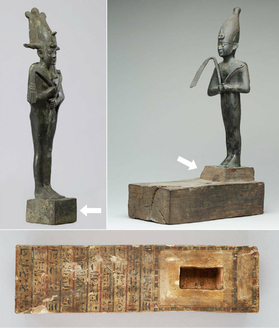
If you've read the previous Sections, you know that this "associating principle" has been already used many times by ancient Egyptians: we've seen it with Bes standing onto himself (the wedging block of the inclined well), and we've seen it with Osiris standing onto himself as well.
The question of to know if the original Osiris stone of the Great Pyramid was actually in cubic form, is still open to debate though, because not only some other sources than the Talmud disagree on the dimensions of the Tablets, but more importantly, the idea of a cube itself could only be another metaphor used to glorify science as many find in a cube the perfect illustration and demonstration of mathematical and scientific knowledge.
Anyway, just like the Osiris stone was giving to the impactor all its ramming power, the Tablets of Stone are giving to the Ark of the Covenant, all its power as well: the power of destruction of the Ark is about ramming and smiting. This is why both the walls of Jericho and the statue of Philistines' god Dagon are being destroyed by the Ark: they've been smitten and rammed by the Ark of the Covenant, because the Ark is about the impactor of the Great Pyramid.
But the Osiris stone wasn't designed to flat down walls and statues: it was designed to ram into the waters of the inclined well of the Great Pyramid, and this is why Joshua needed the Ark to pass the Jordan river: that is the Ark which really is running through the waters of the Jordan, Joshua and his followers are simply "following" the Ark.
The famous scene of Joshua, "passing through the Jordan river with the Ark of the Covenant", should rather be described as Joshua, following the passing of the Ark through the waters of the Jordan river. The Ark of the Covenant is only a reinterpretation of the operation of the wooden and stone composite impactor of the Great Pyramid of Egypt.
Just like the impactor, the Ark of the Covenant is indeed of a composite design, as it is described as a chest made of wood, which contains the Tablets of Stone and they both were supposed to be unseen: just like Medjed "the Smiter nobody could see", the Ark was to be covered and hidden at all times, only because the impactor itself was hidden as well into the central wooden caisson of the Grand Gallery.
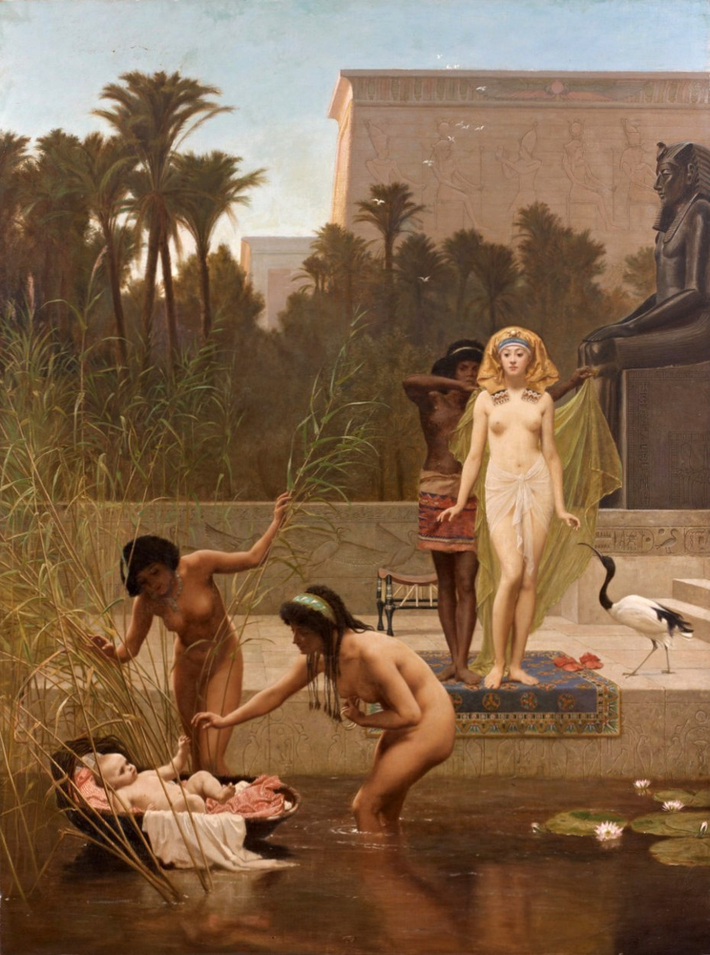
"The Finding of Moses" with the Ibis representation of the ancient Egyptian god of Science Thoth, by Frederick Goodall, 1885: https://en.wikipedia.org/wiki/Finding_of_Moses#/media/File:Frederick_Goodall_-_The_Finding_of_Moses.jpg
40.01 [Moses = Osiris] 1 • The finding of Moses from the waters of the Nile... inside a floating basket
This part of the story of Moses is the one linking Moses and the Ark of the Covenant to the ancient Egyptian god Osiris, and in particular the famous Osiris myth.
Both stories are quite identical: both Osiris and Moses were found and save from the waters of the Nile river, while floating in these waters.
"The Finding of Moses, sometimes called Moses in the Bullrushes, Moses Saved from the Waters, or other variants, is the story in chapter 2 of the Book of Exodus in the Hebrew Bible of the finding in the River Nile of Moses as a baby by the daughter of Pharaoh. The story became a common subject in art, especially from the Renaissance onwards." https://en.wikipedia.org/wiki/Finding_of_Moses
40.02 [Moses = Osiris] 2 • The finding of Osiris from the waters of the Nile... inside a floating coffin
Below are some excerpts of the Osiris myth, in which had been glorified the chore of the operation of the Great Pyramid: the wooden and stone composite nature of the impactor, designed to get in the water.
What is very interesting in this myth, is that it is clearly suggested that first was designed the Osiris stone, and only then, the wooden vessel for the stone had been crafted: "Set, that Wicked One, had in secret measured the body of Osiris, and the coffer was made to fit the body of the King, for this was part of the plan."
What it means is that the ancient Egyptian engineers first had to determine what power they needed in order to pressurize the waters of the well to get the perfect fog of microdroplets in the evaporative cooling passage; and only then they were able to design the wooden coffin, then maybe the gutter and all the Grand Gallery's design: the slope, the length, etc.
More on the Osiris stone in Section 13: https://www.milleetunetasses.com/blog/the-pyramids-of-the-cold-v2/section-13-the-composite-impactor.html
Excerpts of the Osiris myth, from Sacred Texts: https://www.sacred-texts.com/egy/ael/ael08.htm#page_41
"Set hated his brother Osiris, and he gathered to himself seventy-two conspirators […]. And they made a plan that when Osiris returned they should kill him and place Set on the throne; but they hid their plans, and with smiling faces went out to meet Osiris when he re-entered Egypt in triumph."
"In secret they met again and again, in secret also they prepared a coffer made of costly wood painted and decorated with rich designs and glowing colours […]. Set, that Wicked One, had in secret measured the body of Osiris, and the coffer was made to fit the body of the King, for this was part of the plan."
"When all was ready, Set bade his brother and the seventy-two conspirators to a feast in his great banqueting-hall. […] Then Set stood up in his place and said, "He who lies down in this coffer and whom it fits, to that man I will give it." His words were sweet as honey, but in his heart was the bitterness of evil."
"One after one, the conspirators lay down in the coffer with jests and laughter; for one it was too long, and for another it was too short, and for a third it was too wide, and for a fourth too narrow. Then came Osiris to take his turn, and he, all unsuspecting, lay down in it. At once the conspirators seized the lid and clapped it on; some nailed it firmly in its place, while others poured molten lead into all the openings lest he should breathe and live. Thus died the great Osiris."
"The conspirators lifted the chest, which was now a coffin, and carried it to the river-bank. They flung it far into the water, and Hapi the Nile-god caught it and carried it upon his stream to the sea; the Great Green Waters received it and the waves bore it to Byblos and lifted it into a tamarisk-tree that grew by the shore."
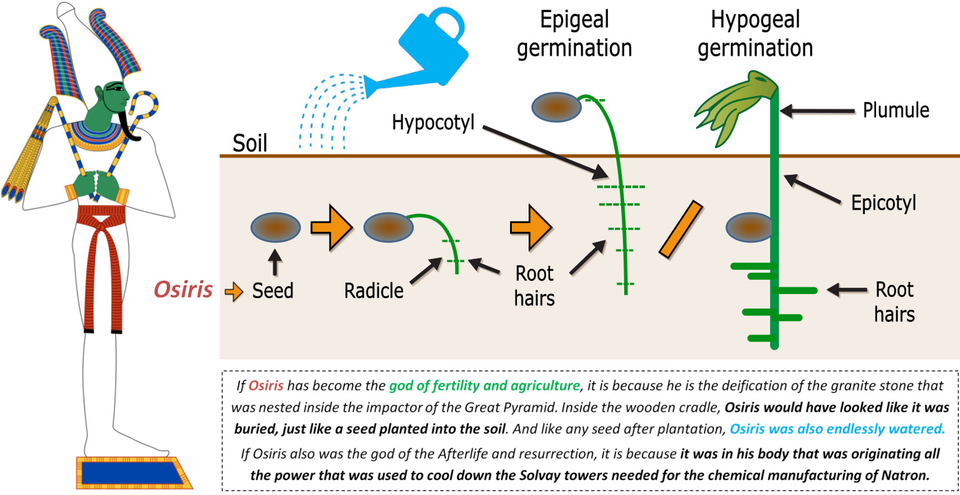
Osiris has been identified with Fertility and Agriculture, because hidden in his wooden cradle coffin, he would have looked like a seed, just waiting for germination. "Epigeal vs. hypogeal germination", by Kat1992: https://en.wikipedia.org/wiki/Epigeal_germination
Ancient Egyptian god Osiris by Jeff Dahl: https://en.wikipedia.org/wiki/Osiris#/media/File:Standing_Osiris_edit1.svg
40.03 [Moses = Osiris] 3 • Moses and the metaphor of the seed drawn-out from water
This is not the first time I stumble upon the seed metaphor of what really represents Osiris: because Osiris is the glorifying deification of the stone weight of the impactor, it would have looked just like a seed, planted into the soil and meticulously watered when ramming into the waters of the inclined well.
The amazing thing is that this same metaphor is clearly known about Moses (the reinterpretation of Osiris himself):
About the meaning of the name of Moses: "Linguist Abraham Yahuda, based on the spelling given in the Tanakh, argues that it combines "water" or "seed" and "pond, expanse of water," thus yielding the sense of "child of the Nile" (mw-š)." https://en.wikipedia.org/wiki/Moses
"The biblical account of Moses' birth provides him with a folk etymology to explain the ostensible meaning of his name. He is said to have received it from the Pharaoh's daughter: "he became her son. She named him Moses [מֹשֶׁה, Mōše], saying, 'I drew him out [מְשִׁיתִֽהוּ, mǝšīṯīhū] of the water'." This explanation links it to the Semitic root משׁה, m-š-h, meaning "to draw out". https://en.wikipedia.org/wiki/Moses
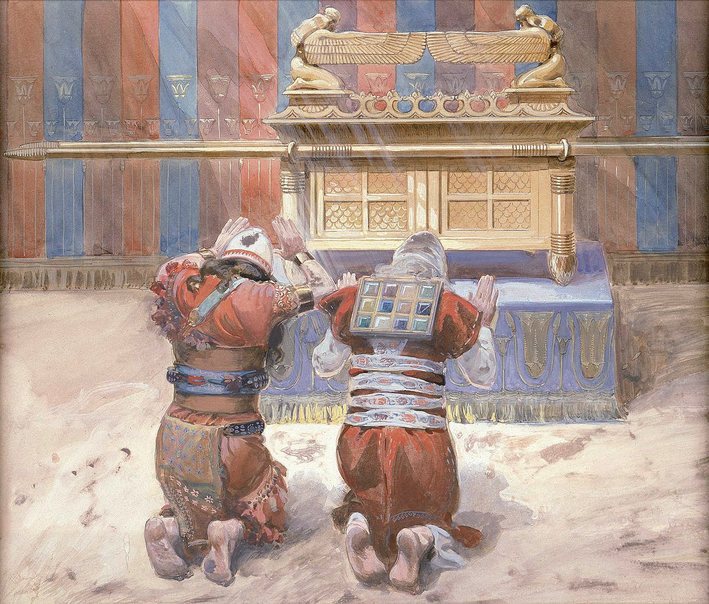
Moses and Joshua in the Tabernacle, bowing before the Ark, c. 1896-1902, by James Jacques Joseph Tissot (French, 1836-1902) or follower, at the Jewish Museum, New York: https://thejewishmuseum.org/collection/26402-moses-and-joshua-in-the-tabernacle
40.04 The Ark of the Covenant: a wooden and stone composite design... just like the impactor of the Great Pyramid of Egypt
"The Ark of the Covenant, also known as the Ark of the Testimony or the Ark of God, is a legendary artifact believed to be the most sacred relic of the Israelites, which is described as a wooden chest, covered in pure gold, with an elaborately designed lid called the mercy seat. According to the Book of Exodus [Old Testament], the Ark contained the two stone tablets of the Ten Commandments.
[…] The biblical account relates that approximately one year after the Israelites' exodus from Egypt, the Ark was created according to the pattern given to Moses by God when the Israelites were encamped at the foot of Mount Sinai. Thereafter, the gold-plated acacia chest was carried by its staves by the Levites approximately 2,000 cubits (approximately 800 meters or 2,600 feet) in advance of the people when on the march. God spoke with Moses "from between the two cherubim" on the Ark's cover.
According to the Book of Exodus, God instructed Moses to build the Ark during his 40-day stay upon Mount Sinai. He was shown the pattern for the tabernacle and furnishings of the Ark, and told that it would be made of shittim wood (also known as acacia wood) to house the Tablets of Stone. Moses instructed Bezalel and Aholiab to construct the Ark.
The Book of Exodus gives detailed instructions on how the Ark is to be constructed. It is to be 2+1⁄2 cubits in length, 1+1⁄2 cubits breadth, and 1+1⁄2 cubits height (approximately 131×79×79 cm or 52×31×31 in) of acacia wood. Then it is to be gilded entirely with gold, and a crown or molding of gold is to be put around it. Four rings of gold are to be attached to its four corners, two on each side—and through these rings staves of shittim wood overlaid with gold for carrying the Ark are to be inserted; and these are not to be removed. A golden lid, the kapporet (translated as 'mercy seat' or 'cover'), which is ornamented with two golden cherubim, is to be placed above the Ark. Missing from the account are instructions concerning the thickness of the mercy seat and details about the cherubim other than that the cover be beaten out over the ends of the Ark and that they form the space where God will appear. The Ark is finally to be placed under a veil to conceal it."
https://en.wikipedia.org/wiki/Ark_of_the_Covenant
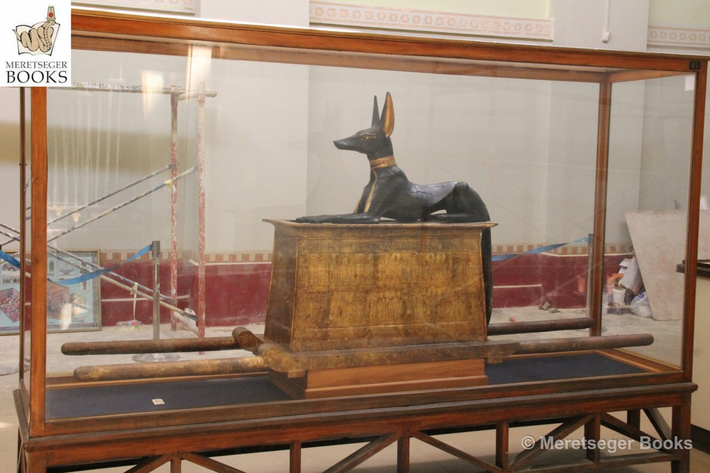
An Anubis Chest (or shrine) from the tomb of King Tutankhamun in the Valley of the Kings, Western Thebes, now in the Egyptian Museum in Cairo. Credit: https://www.meretsegerbooks.com/gallery/935/anubis-shrine
40.05 The Ark of the Covenant and the Anubis Chest in the tomb of Tutankhamun
Of course the similarities between the ancient Egyptian and Hebrew artifacts are stunning; but what is maybe the most important remark to make here on the Anubis chest, is that there really is the sledge on which is set the "Chest".
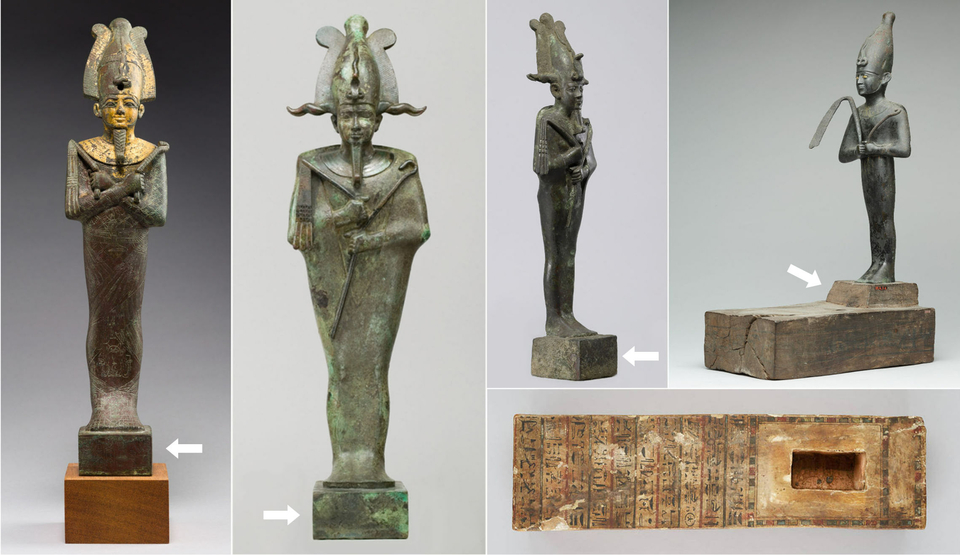
Statuette of Osiris Late Period ca. 588–526 B.C. at the MET: https://www.metmuseum.org/art/collection/search/546747
Statuette of Osiris" Late Period 664–332 B.C. at the Metropolitan Museum of Art, New-York: https://www.metmuseum.org/art/collection/search/545802
Figure of Osiris at the Walters Art Museum, Baltimore MD: https://art.thewalters.org/detail/36613/statue-of-osiris/
Osiris offered by the Astronomer of the House of Amun, Ibeb. Third Intermediate Period, ca. 1070–712 B.C. at the MET: https://www.metmuseum.org/art/collection/search/547898
40.06 According to the Talmud, the assembled Tablets of Stone would have formed a perfect cube with 50 cm wide sides
Even if sources seem to disagree, it looks like the Talmud is giving us the most accurate and genuine dimensions of the Tablets of Stone (if they really existed in the first place).
What is amazing is that if you assemble both Tablets, just like they would have been assembled to fit in the Ark of the Covenant, they form a perfect cube, with 50 centimeters-wide sides.
In other words, the assembled Tablets of Stone are forming a perfect cubic block of stone; that cube is the Osiris stone.
"According to the Talmud, each Tablet was square, six Tefachim (approximately 50 centimeters, 20 inches) wide and high, and more a thicker block than a tablet, at three Tefachim (25 centimeters, 10 inches) thick, though they tend to be shown larger in art. (Other Rabbinic sources say they were rectangular rather than square, six Tefachim high and three wide and deep.) Also according to tradition, the words were not engraved on the surface, but rather were bored fully through the stone." https://en.wikipedia.org/wiki/Tablets_of_Stone
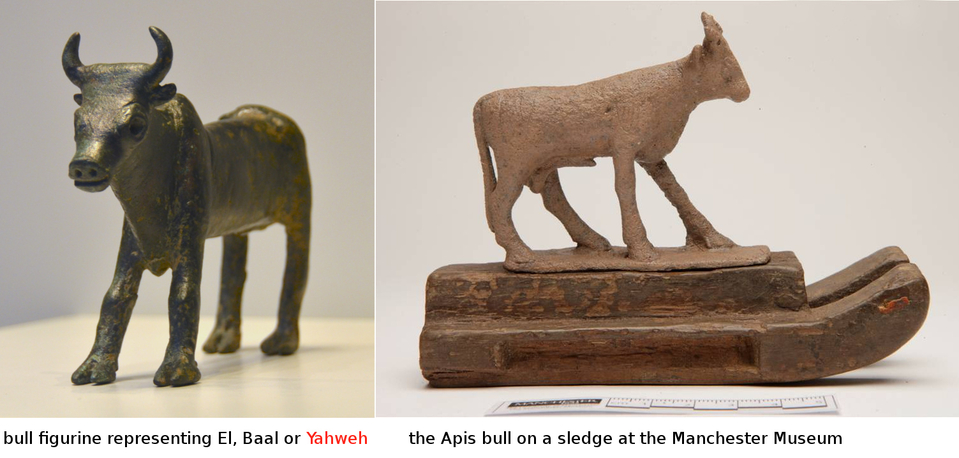
Image on the right: "This small (8.2 x 7.5cm) copper alloy statuette depicts the sacred Apis bull – recognisable by the remains of a sun disk between its curved horns. The bull was at the centre of an elaborate cult, and was believed to be the earthly incarnation of the god Ptah". Manchester Museum: https://egyptmanchester.wordpress.com/2012/07/23/object-biography-7-a-statuette-of-the-apis-bull-acc-no-13000a-b/
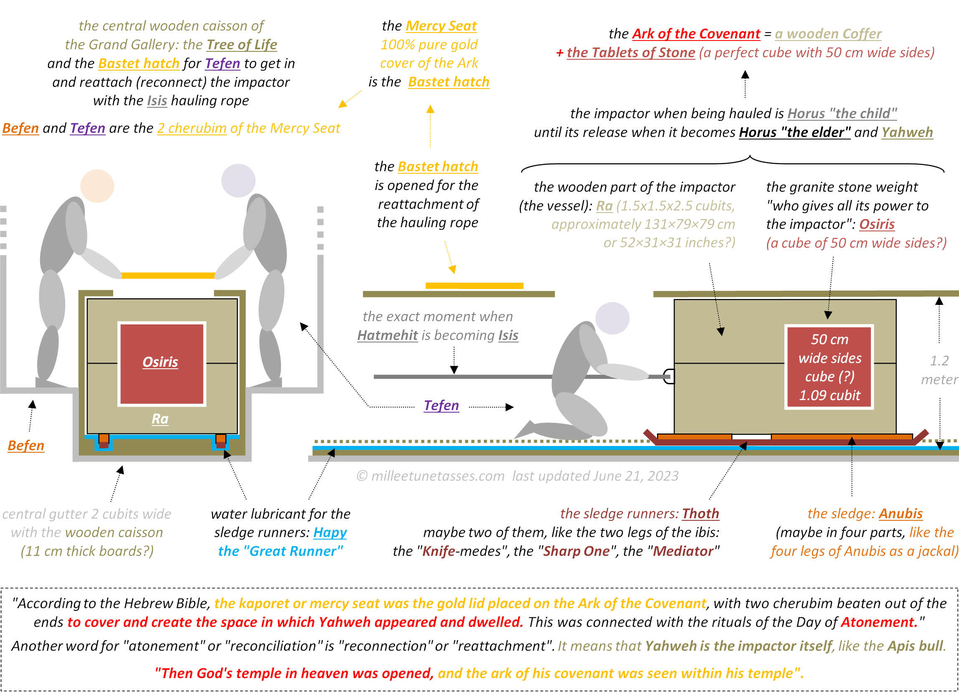
40.07 The Mercy seat lid of the Ark of the Covenant is the Bastet hatch from which could be seen the impactor Yahweh
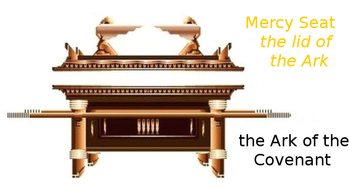
"According to the Hebrew Bible, the kaporet (Hebrew: כַּפֹּרֶת kapōreṯ) or mercy seat was the gold lid placed on the Ark of the Covenant, with two cherubim beaten out of the ends to cover and create the space in which Yahweh appeared and dwelled. This was connected with the rituals of the Day of Atonement. The term also appears in later Jewish sources, and twice in the New Testament, from where it has significance in Christian theology". https://en.wikipedia.org/wiki/Mercy_seat
"Then God's temple in heaven was opened, and the ark of his covenant was seen within his temple. There were flashes of lightning, rumblings, peals of thunder, an earthquake, and heavy hail." Revelation 11:19 ESV / 16 helpful votes: https://www.openbible.info/topics/mercy_seat
40.08 The Mercy Seat: "atonement" is about "reconciliation"... and "reattachment" or "reconnection"
Synonyms of atonement from https://www.merriam-webster.com/dictionary/atonement
1 • reparation for an offense or injury : satisfaction
2 • the reconciliation of God and humankind through the sacrificial death of Jesus Christ
3 • Christian Science: the exemplifying of human oneness with God
4 • obsolete: reconciliation
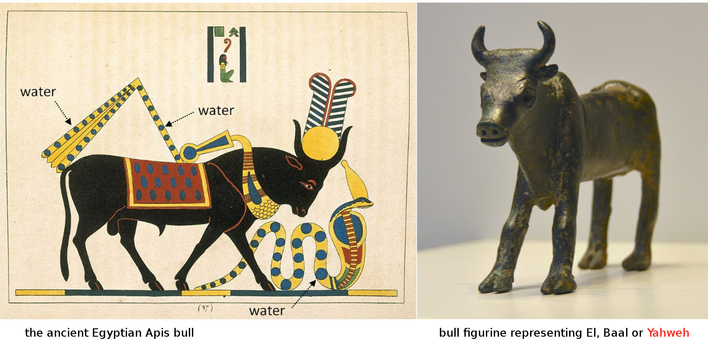
Api or Hapi (Apis, Taureau Consacré a la Lune)", 1823-25, by the French illustrator Léon-Jean-Joseph Dubois, at the Brooklyn Museum: https://www.brooklynmuseum.org/opencollection/archives/image/55326
Early Iron Age bull figurine from Bull Site at Dhahrat et-Tawileh (modern West Bank, ancient Ephraim), representing El, Baal or Yahweh. Photograph by Nathaniel Ritmeyer: https://en.wikipedia.org/wiki/Yahweh#/media/File:Bull_site_statuette.png
40.09 The meaning of Yahweh as a bull is the same as the meaning of the Apis bull
On the left is the ancient Egyptian Apis bull, representing the force and power of the impactor of the Great Pyramid and demonstrating the high speed it achieved in the central wooden caisson, pushing the water in front of its path and projecting water plumes behind its path (more in Section 18): the snake is a representation of the ripples on the water and the flail indicates the direction of the water plumes to the back of the bull.
Both Yahweh and the Apis bull are deifications of the impactor of the Great Pyramid, and the glorification of their force, power and energy.
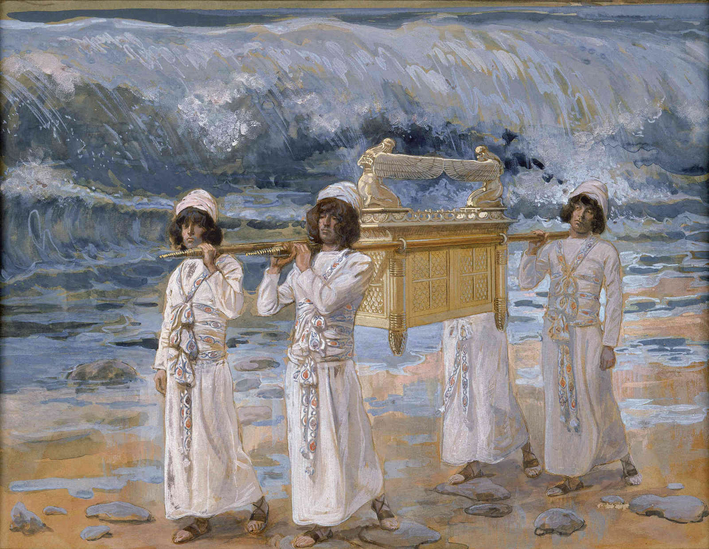
"The Ark Passes Over the Jordan", by French artist James Jacques Joseph Tissot, 1836-1902: https://thejewishmuseum.org/collection/26409-the-ark-passes-over-the-jordan
40.10 The complex meaning of the Ark of the Covenant combining the impactor + the central caisson + the Bastet hatch
I first thought the Ark of the Covenant was only about the impactor: we had the dimensions of the granite Osiris weight (the Tablets of Stone) and the dimensions of the wooden impactor (the Ark itself); but I also realized that according to the Bible, the Ark was made with Acacia wood, and it didn't match with the ancient Egyptian texts where it is more than suggested that the impactor would have been made with Tamarix wood (Section 13).
It is only then I understood the meaning of the Mercy Seat, the lid made with pure gold and from which one could finally see Yahweh, the Jewish deity who was represented into a bull, just like the Apis bull.
If you can see Yahweh as a bull (the impactor) from the (open) lid, it means that the lid is the Bastet hatch of the central wooden caisson of the Grand Gallery.
What it means is that the Ark of the Covenant is much more complex than just another representation of the impactor of the Great Pyramid: of course, we strongly have to consider that the dimensions given by the Talmud are indeed about the impactor, but it's like the central wooden caisson of the Gallery (the "Tree of Life") has been reduced to these same dimensions, because we've already seen that the Tree of Life central caisson of the Gallery was indeed made with acacia wood.
So this is the first level of comprehension of the Ark: it is both about the impactor and the central caisson.
But on top of this is a third level of comprehension with the Mercy Seat lid: because the wooden chest of the Ark is directly about the caisson of the Gallery, the lid of the chest has been covered with the lid of the caisson: the Bastet hatch.
• the impactor of the Great Pyramid within the Ark of the Covenant: wooden and stone composite design + dimensions.
• the central wooden caisson of the Grand Gallery within the Ark of the Covenant: the Bastet hatch lid of the acacia wood chest.
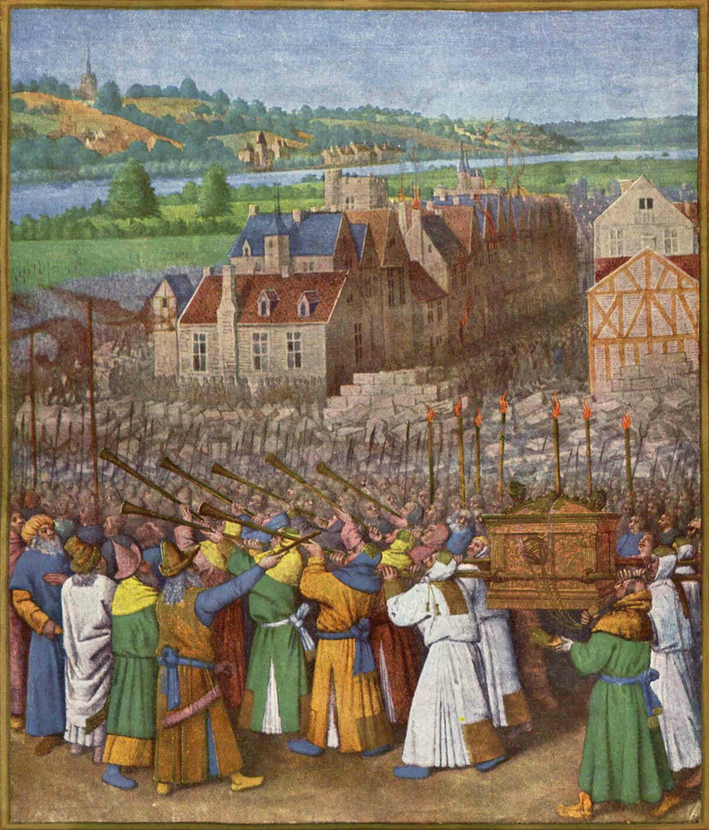
Depiction of the battle of Jericho, showing that it's wall had been literally blown-up by the Ark of the Covenant, as it is so elegantly suggested by the seven blowing trumpets preceding the Ark; by Jean Fouquet (c. 1415–1420): https://en.wikipedia.org/wiki/Battle_of_Jericho#/media/File:Jean_Fouquet_001.jpg
40.11 [The smiting Ark of the Covenant] 1 • The destruction of the wall of Jericho
Everybody knows about the Ark of the Covenant and its tremendous power of destruction, as it is emphasized in the first movie starring Indiana Jones: "Philip Kaufman conceived of the Ark of the Covenant as the main plot device of Steven Spielberg's 1981 adventure film Raiders of the Lost Ark, where it is found by Indiana Jones in the Egyptian city of Tanis in 1936." https://en.wikipedia.org/wiki/Ark_of_the_Covenant
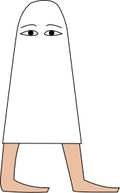
Historically, the Ark of the Covenant was so powerful that it completely destroyed both the wall of Jericho during the Battle of Jericho, and the statue of Philistine's god Dagon, when the Philistines had stolen the Ark. Both the wall of Jericho and the statue of Dagon ended up broken into pieces and laid flat onto the ground.
In other words, the Ark of the Covenant and the ancient Egyptian god Medjed have the exact same power: both Medjed and the Ark of the Covenant have smiting powers and should be called "the Smiter".
More on the unseen ancient Egyptian "smiter" god Medjed in Section 17: https://www.milleetunetasses.com/blog/the-pyramids-of-the-cold-v2/section-17-medjed.html
A depiction of the ancient Egyptian "smiter" god Medjed based on the Greenfield papyrus, by Di (they-them): https://commons.wikimedia.org/wiki/File:Medjed.svg
"According to the Bible, at around 1,400 BCE, Jericho was the first city attacked by the Israelites after they crossed the Jordan River and entered Canaan. The Wall of Jericho was destroyed when the Israelites walked around it for seven days carrying the Ark of the Covenant. On the seventh day, Joshua commanded his people to blow their trumpets made of rams' horns and shout at the walls until they finally fell down." https://www.worldhistory.org/article/951/early-jericho/
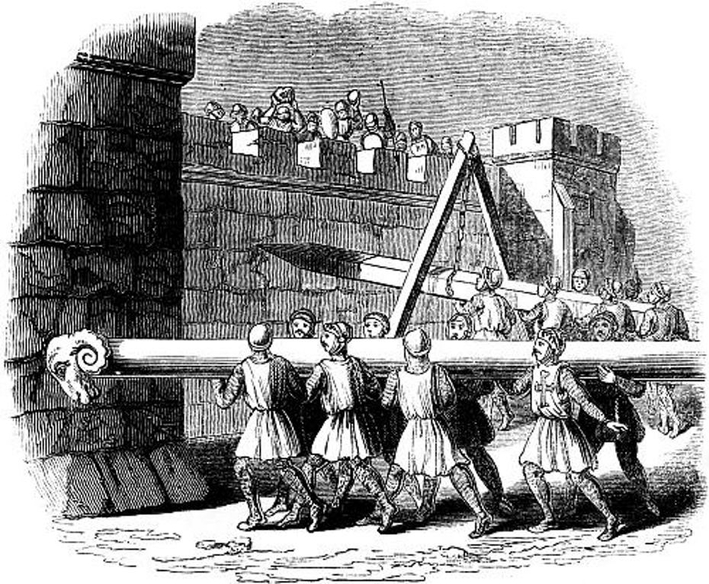
Attack on the Walls of a besieged Tower (shows a battering ram): https://commons.wikimedia.org/wiki/Category:Battering_rams#/media/File:0869-Attack-on-the-walls-of-a-besieged-town-q75-500x412.jpg
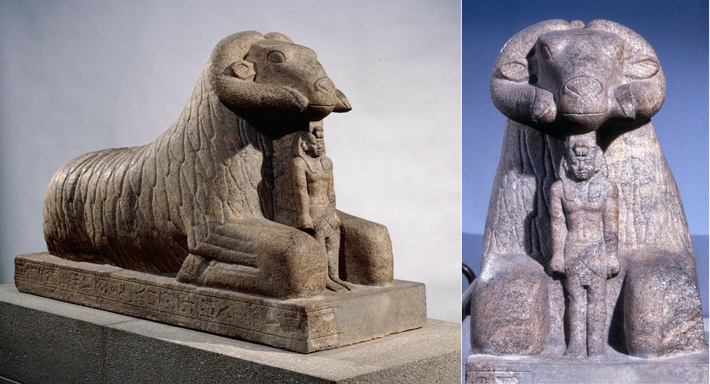
King Taharqa is here represented under the head of the ram to proclaim he was strong enough to sustain the pressure applied by the ram's head. Image from the British Museum: https://www.britishmuseum.org/collection/object/Y_EA1779
40.12 The representations of pharaohs under rams' heads to demonstrate their own ramming and smiting power
We've already seen many times that ancient Egyptians glorified many things of the operation of the Great Pyramid, but what the pharaohs seemed to be the most proud of was two things:
• their ability to raise the Osiris stone "into the air", hence the only thing we actually know about these structures: the fact that they were all about "raising the golden Benben stone" into the air, literally "from water".
• their ability to demonstrate their ramming power, hence the numerous representations of pharaohs representing their own body under the head of the ram, just like they were saying:
• "I'm stronger than this ram, he cannot defeat me"
• or "All my power comes from this ram, I have all his power".
Of course, this interpretation of King Taharqa under the ram's head is not academic, as the British Museum indicates about the above figure: "Granitic gneiss sphinx of the ram of Amun protecting figure of Taharqo between folded front legs".
"Taharqa, also spelled Taharka or Taharqo, was a pharaoh of the Twenty-fifth Dynasty of Egypt and qore (king) of the Kingdom of Kush (present day Sudan), from 690 to 664 BC. He was one of the "Black Pharaohs" who ruled over Egypt for nearly a century." https://en.wikipedia.org/wiki/Taharqa
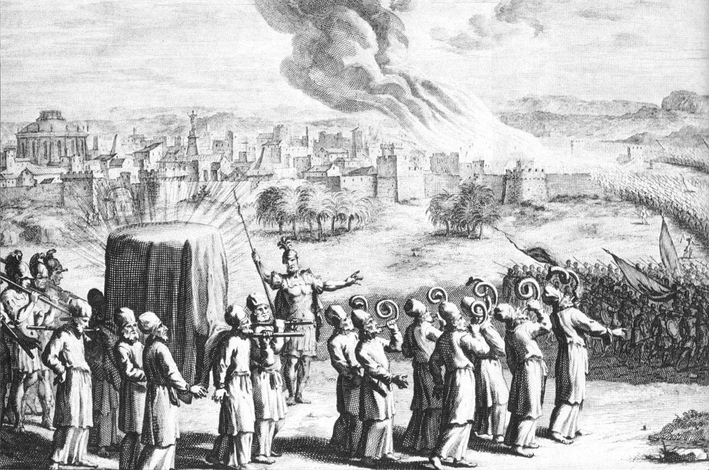
"The covered ark and seven priests with rams' horns, at the Battle of Jericho, in an 18th-century artist's depiction." https://en.wikipedia.org/wiki/Ark_of_the_Covenant#/media/File:Schrana01.jpg
40.13 [The smiting Ark of the Covenant] 4 • The seven priests with the ram's horns
It really is surprising to note that I haven't seen any study on the Ark of the Covenant clearly mentioning the ramming, or smiting metaphor about the destruction of the wall of Jericho; but what else could have done the job than a battering ram? Of course this war machine is only metaphoric, but it perfectly introduces the reason why rams are all over the Battle of Jericho's illustrations, just like in the above drawing of the Battle, showing seven priests with ram's horns (or seven trumpets on many other illustrations).
The meaning of the ram's horns is clear: the wall of Jericho have been destroyed by a battering ram-like Ark of the Covenant, that is represented right behind the priests with the ram's horns.
In other words, that is the Ark that is ramming into the wall of Jericho; and if you don't know that the Ark is about the impactor of the Great Pyramid, there is no way you can understand why, and how the Ark of the Covenant could have such destroying power.
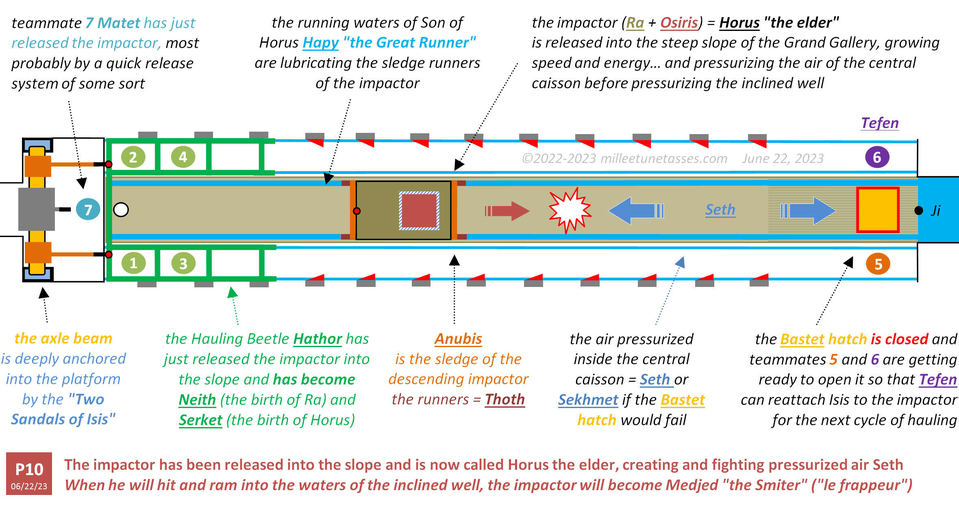
Operating phase P10 of the Grand Gallery of the Great Pyramid of Giza, showing the pressurization of the central wooden caisson, even before the impactor actually rams into the waters of the inclined well. The complete phases P1 to P10 are described in Section 26: https://www.milleetunetasses.com/blog/the-pyramids-of-the-cold-v2/section-26-the-10-operating-phases-of-the-gallery.html
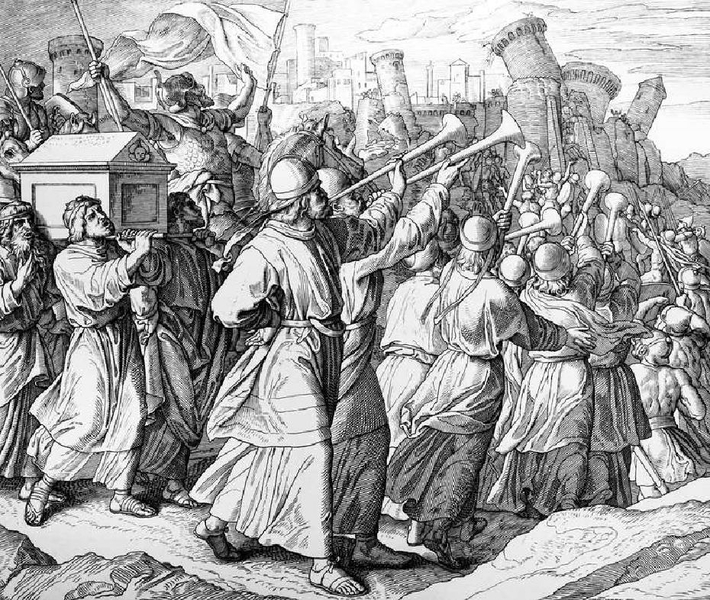
Depiction of the battle of Jericho, showing that it's wall had been literally blown-up by the Ark of the Covenant, as it is so elegantly suggested by the seven blowing trumpets preceding the Ark; by Julius Schnoor von Carolsfeld (1794–1872): https://en.wikipedia.org/wiki/Battle_of_Jericho#/media/File:JSC_the_battle_of_Jericho.png
40.14 The seven sounding trumpets of rams' horns are about the pressurized air preceding the fall of the impactor
What is interesting with the priests sounding rams' horns or trumpets made with rams' horns, is that they are actually even better describing what really happened with the impactor of the Great Pyramid.
We've already seen that in order to produce evaporative cold in a cycle process, the wet air had to be evacuated at some point so that the evaporative process could occur; the process needs dry air to work. That is the reason of why the impactor had to be placed inside a confine space, the "central wooden caisson of the Gallery", to use the dry air that was pushed by the fall of the impactor inside this caisson and redirected towards the evaporative passage.
This pressurized air, is what the sounding rams' horns and trumpets are all about; and this is why they are always preceding the Ark of the Covenant: the pressurized air always preceded the impactor.
"During the Battle of Jericho, the Ark was carried around the city once a day for six days, preceded by the armed men and seven priests sounding seven trumpets of rams' horns. On the seventh day, the seven priests sounding the seven trumpets of rams' horns before the Ark compassed the city seven times and, with a great shout, Jericho's wall fell down flat and the people took the city". https://en.wikipedia.org/wiki/Ark_of_the_Covenant
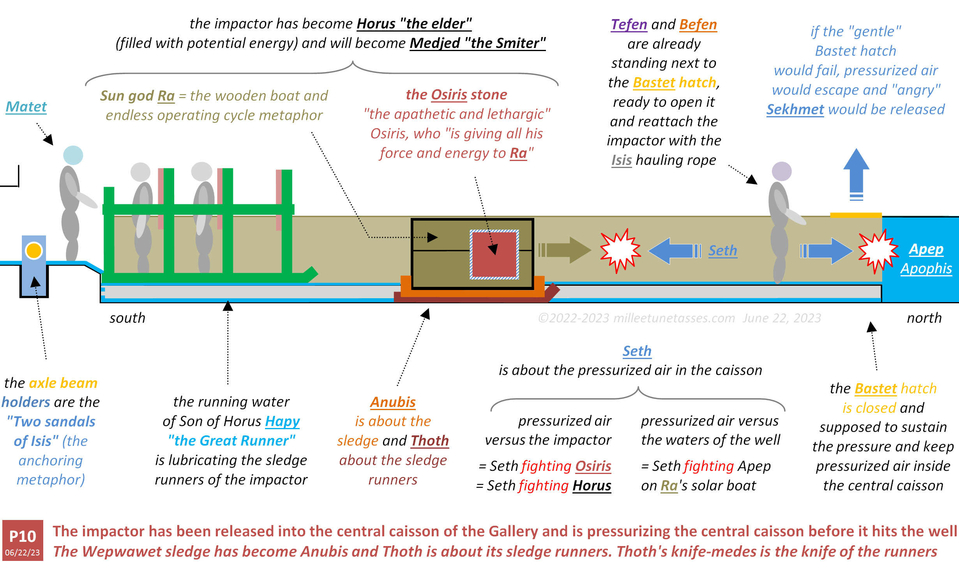
Operating phase P10 of the Grand Gallery, showing the location of the Bastet hatch used for the pressurization of the central wooden caisson of the Gallery. Pressurized air was needed to evacuate the wet air of the previous cycle that accumulated in the evaporative cooling passage and the Queen chamber.
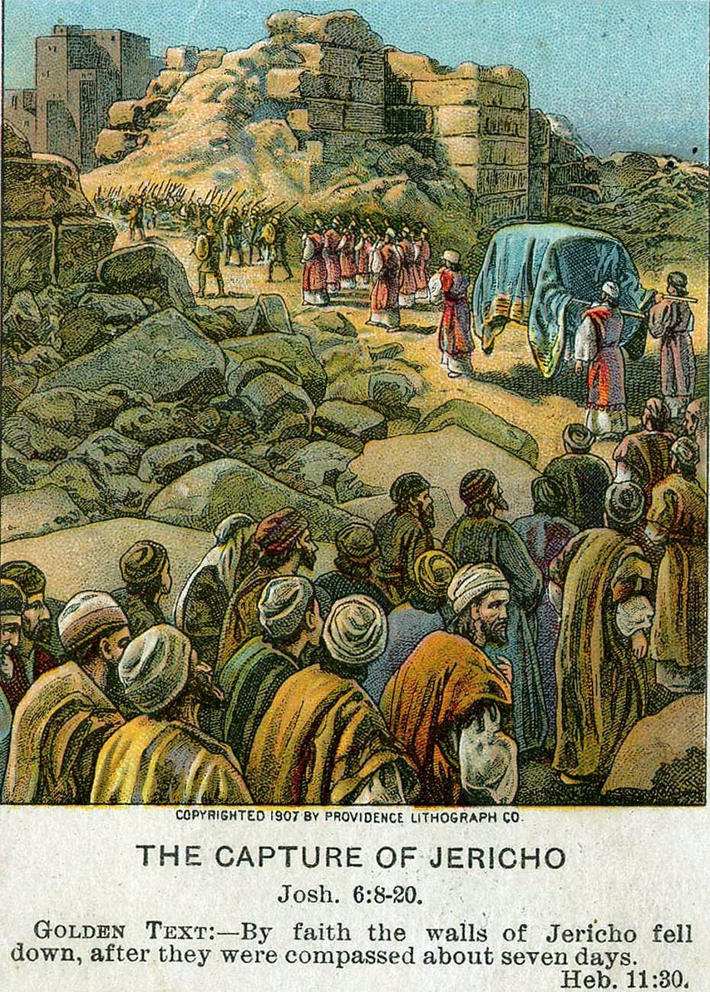
The Capture of Jericho; as in Joshua 6:8-20; illustration from a Bible card published by the Providence Lithograph Company: https://thebiblerevival.com/clipart/1907/josh6.jpg
40.15 [The smiting Ark of the Covenant] 4 • The Ark was carried around not for six days, but by six men
This part really is beautiful: instead of describing the basic operation of the Grand Gallery of the Great Pyramid like we would do today, using words like "crewmembers", "teammates", "impactor" or "rotation of an axle beam shaft", the Jewish religion used expressions like "6 days", "seventh day", "carrying the Ark of the Covenant" and "circling around a city", just like ancient Egyptians themselves had already created the glorifying myth of Isis and the Seven Scorpions. For example, the process of hauling the impactor by the 6 crewmembers of the Beetle becomes "carrying the Ark of the Covenant for 6 consecutive days" and the process of putting the axle beam shaft in a rotation movement becomes a (quite) endless circling movement of the Ark around the city of Jericho.
So instead of saying: "the wooden and stone impactor [of the Great Pyramid] was hauled by 6 crewmembers of a hauling Beetle which induced the rotation of an axle beam shaft; and at the very end of the hauling process, the impactor would be released by a seventh teammate and would ram and smite the waters of the inclined well of the Pyramid"…
… the Jewish version becomes: "you will build a wooden chest and you will put in the chest 2 stones which combined will form a perfect cube of stone; then you will circle around the wall of Jericho, once a day for 6 consecutive days carrying the chest you would call the Ark of the Covenant, and on the very last and seventh day, the wall would be flat-down and destroyed, just like it would if attacked by a battering ram".
Just like the myth of Osiris being saved from the waters of the Nile, have been reinterpreted into the Moses myth, the hauling process of the impactor of the Great Pyramid, as well as its release and its ramming power, have also been replicated in the Jewish religion about 2500 years after the events really occurred in the Great Pyramid.
"During the Battle of Jericho, the Ark was carried around the city once a day for six days, preceded by the armed men and seven priests sounding seven trumpets of rams' horns. On the seventh day, the seven priests sounding the seven trumpets of rams' horns before the Ark compassed the city seven times and, with a great shout, Jericho's wall fell down flat and the people took the city". https://en.wikipedia.org/wiki/Ark_of_the_Covenant
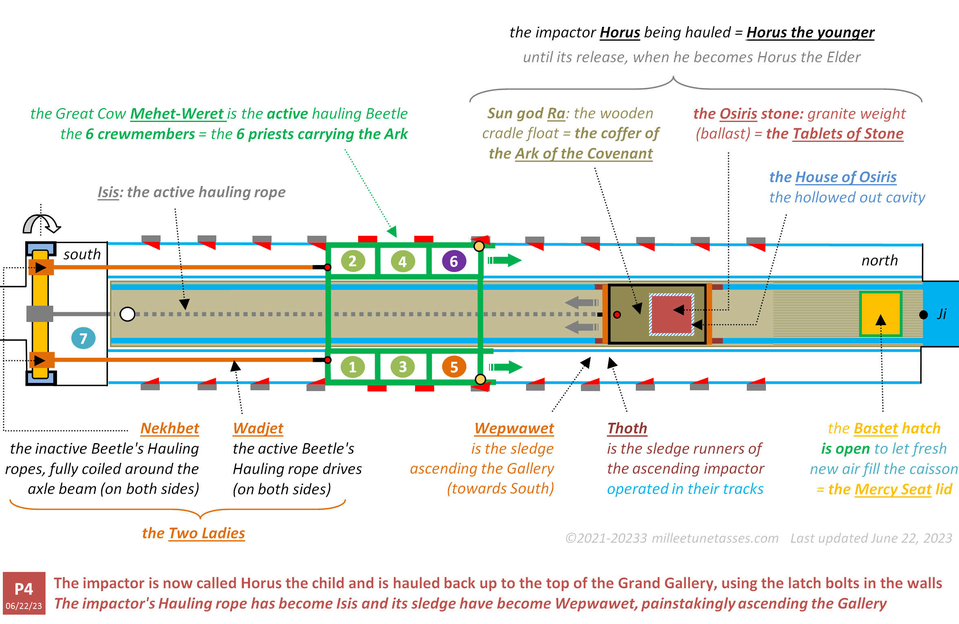
This is not days it is really all about, but men: the Ark of the Covenant was supposed to be carried by 6 men.
"During the Battle of Jericho, the Ark was carried around the city once a day for six days, preceded by the armed men and seven priests sounding seven trumpets of rams' horns. On the seventh day, the seven priests sounding the seven trumpets of rams' horns before the Ark compassed the city seven times and, with a great shout, Jericho's wall fell down flat and the people took the city". https://en.wikipedia.org/wiki/Ark_of_the_Covenant
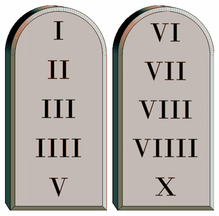
40.16 The Ten Commandments were originally only about Ten Words: the One to Ten numbers
The Ten Commandments are a perfect example of what happened in the ancient World, regarding the transmission of knowledge and all the glorifying process that accompanied the transmission.
We already know that the so-called "Tablets of Stone" weren't tablets at all; combined together they would have create a perfect cube with 50 cm wide sides; but what we also know for sure, is that at the very origin of the Ten Commandments as we know them today, were only ten words:
"The Ten Commandments (Biblical Hebrew עשרת הדברים \ עֲשֶׂרֶת הַדְּבָרִי, aséret ha-dvarím, literally: The Ten Words" https://en.wikipedia.org/wiki/Ten_Commandments
It means that originally, what really triggered the very existence of the Tablets of Stone were these 1 to 10 numbers, and from these numbers had been added the set of biblical principles relating to ethics and worship that play a fundamental role in Judaism and Christianity as we know them today.
"The Ten Commandments, called עשרת הדברים \ עֲשֶׂרֶת הַדְּבָרִי (transliterated aséret ha-dvarím) in Biblical Hebrew, are mentioned at Exodus 34:28, Deuteronomy 4:13 and Deuteronomy 10:4. In all sources, the terms are translatable as "the ten words", "the ten sayings", or "the ten matters". In Mishnaic Hebrew they are called עשרת הדיברות \ עֲשֶׂרֶת הַדִּבְּרוֹת, aséret ha-dibrót, lit. "the ten sayings" or "the ten utterances." In the Septuagint, the Greek translation of the Hebrew Bible was translated as δεκάλογος, dekalogos or "ten words"; this Greek word became decalogus in Latin, which entered the English language as "Decalogue", providing an alternative name for the Ten Commandments."
40.17 The Ten Commandments and the ten operating phases of the Grand Gallery
We've just seen that Moses, holding the two Tablets of Stone, really is all about these stones: by holding them in both hands, Moses is telling us he really is the combination of these stones. In other words, Moses is the cube of stone nested inside the Ark of the Covenant, and the Jewish reinterpretation of the Osiris stone nested inside the impactor of the Great Pyramid.
It means that the Ten Commandments are directly about the operating cycle of the Osiris stone.
The first thing to keep in mind, is that if I personally imagined ten phases in the operation of the Grand Gallery (P1 to P10, in Section 26), it was only what looked appropriate at the time; I first started with one single diagram to illustrate the process of hauling the impactor, but when I started to decipher the gods and goddesses involved in the glorifying process of the Grand Gallery's operation, I had to add three other diagrams (that was P1 to P4) before getting to a total of 10 diagrams at the end of the deciphering process.
These P1 to P10 phases of operation of the Grand Gallery are coming from a very meticulous and analytical obsessional modern mind, but I would bet that ancient Egyptians would have had the exact same desire to cut the process into a few different steps.
They would have needed their own phases, these steps, for at least three reasons:
• the development of the Grand Gallery's design and operating cycle (including the hauling Beetle, impactor, latch bolts, etc.)
• the training of new teammates
• the actual work of hauling in the Grand Gallery
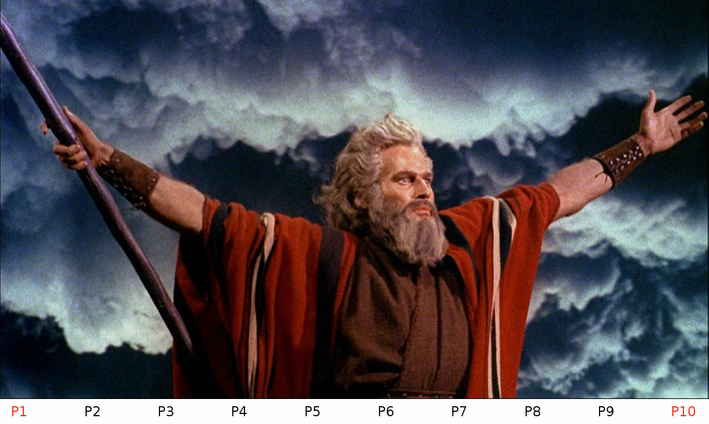
Charlton Heston in The Ten Commandments, 1956: https://en.wikipedia.org/wiki/Moses#/media/File:Charlton_Heston_in_The_Ten_Commandments_film_trailer.jpg
40.18 The ten commands of the Grand Gallery's leader and the Ten Commandments
Of course, the second reason is the most important. We've already seen that the leader of the Grand Gallery's teammates (deified into Matet, the seventh Scorpion of Isis), had already two major roles to accomplish from the top platform of the Gallery:
• secure the impactor at the end of the hauling process (when the 6 crewmembers of the Beetle are the very bottom of the Gallery)
• release the impactor
But there had to be another one: he also had to give the hauling rhythm as well as the orders which had to accompany the different phases of the operation.
And if I came up with ten phases of operation of the Gallery, it is not impossible that ancient Egyptians as well came up with ten phases.
The Ten Commandments have to be about these ten phases. This is only logical. Of course, it doesn't mean that "my 10 phases of operation of the Gallery" are the same ones that the ancient Egyptians came up with: they could have see the process in a complete different way. "My ten phases" are probably mostly reflecting my way of thinking and the need I had to explain what the gods and goddesses involved in the process were really about.
Probably ancient Egyptians had a more practical approach of the phases and they would have been more interested in the orders that the leader would have to shout.
The only thing I'm sure about is the number of phases that I and they've came up with, and that number is Ten.
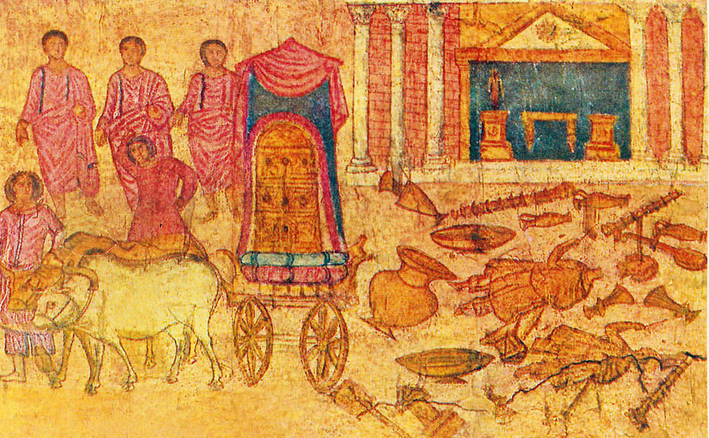
The statue of Dagon, broken into pieces by the Ark of the Covenant. Fresco of the Philistine captivity of the ark, in the Dura-Europos synagogue: https://en.wikipedia.org/wiki/Philistine_captivity_of_the_Ark#/media/File:DuraSyn-WB4-Ark_and_Temple_of_Dagon.jpg
40.19 [The smiting Ark of the Covenant] 2 • The smiting of Philistine god Dagon's statue by the Ark of the Covenant
What is particularly interesting in the story of the Ark of the Covenant being stolen by the Philistines (certainly just another myth), ending up with the smiting of the statue of their principle god Dagon, is that Dagon was their god of seed and agriculture.
It isn't said so clearly in the english Wikipedia's page about this god, but it is in the french version; and because we know now what really is the Ark all about, we understand perfectly the real meaning of the myth: according to the myth, most certainly written by Jews themselves to demonstrate their superiority, by having both the Ark of the Covenant and the statue of Dagon in the same temple, it is both the Philistine god of Seed and Agriculture and the reinterpretation of the ancient Egyptian god of Agriculture who are confronting each other.
But of course, the confrontation is not at all really about agriculture: when Dagon is faced with the Ark, he is actually facing Moses himself, the reinterpretation of Osiris as the impactor of the Great Pyramid.
And the message is clear: when the Philistines come back in the temple of Dagon, first thing in the morning, what they see is that their own "great Smiter Dagon", so to speak, have been broken into pieces and was lying flat onto the ground, defeated by the "great Jewish Smiter".
"The Philistine captivity of the Ark was an episode described in the biblical history of the Israelites, in which the Ark of the covenant was in the possession of the Philistines, who had captured it after defeating the Israelites in a battle at a location between Eben-ezer, where the Israelites encamped, and Aphek (probably Antipatris), where the Philistines encamped." https://en.wikipedia.org/wiki/Philistine_captivity_of_the_Ark
"In the Hebrew Bible, Dagon is referenced three times as the head god of the Philistines; however, there are no references to Dagon as a Canaanite god. According to the Bible, his temples were located at Beth-dagon in the territory of the tribe of Asher (Joshua 19.27), and in Gaza (see Judges 16.23, which tells soon after how the temple is destroyed by Samson as his last act). Another temple, located in Ashdod, was mentioned in 1 Samuel 5:2–7 and again as late as 1 Maccabees 10.83 and 11.4." https://en.wikipedia.org/wiki/Dagon
"Dagon, forme ancienne Dagan, est un important dieu des populations sémitiques du Nord-Ouest du Moyen-Orient. Il est le dieu des semences et de l'agriculture et fut révéré par les anciens Amorrites, les habitants d'Ebla, d'Ougarit et fut un des dieux principaux des Philistins. Très tardivement dans son histoire, à partir du ive siècle, on le trouve représenté sous la forme d'un poisson (dag en hébreu)." https://fr.wikipedia.org/wiki/Dagon_(dieu)
"The account in 1 Samuel 5.2–7 relates how the Ark of the Covenant was captured by the Philistines and taken to Dagon's temple in Ashdod. The following morning the Ashdodites found the image of Dagon lying prostrate before the ark. They set the image upright, but again on the morning of the following day they found it prostrate before the ark, but this time with head and hands severed, lying on the miptān translated as "threshold" or "podium". The account continues with the puzzling words raq dāgōn nišʾar ʿālāyw, which means literally "only Dagon was left to him." (The Septuagint, Peshitta, and Targums render "Dagon" here as "trunk of Dagon" or "body of Dagon", presumably referring to the lower part of his image." https://en.wikipedia.org/wiki/Dagon
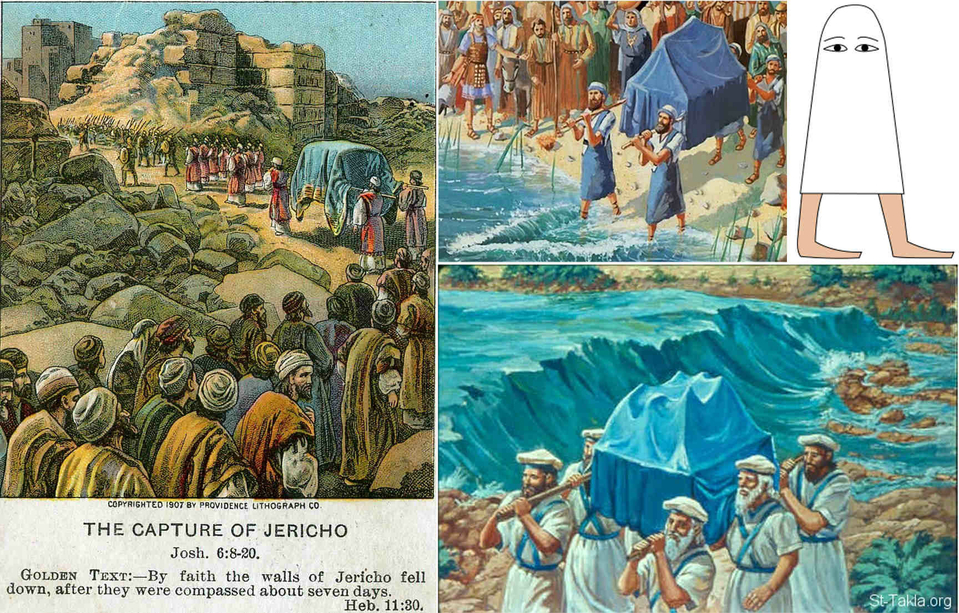
40.20 The Ark of the Covenant wasn't to be seen just like Medjed because the impactor wasn't to be seen either
Even if about half the time, the Ark of the Covenant is depicted without any cover, the texts are clear: the Ark was supposed to be hidden at all times, whether below a cover or inside the Tabernacle and could have only been visible by the highest priests.
We've already seen that the Ark of the Covenant was a smiter, destroying walls and statues, just like the ancient Egyptian god Medjed would have been able to do, because of his "Smiter" epithet.
So it is not a surprise that just like Medjed, who couldn't have been seen by anybody and who was represented as so, with a cover on the head, the Ark of the Covenant as well couldn't have been seen either and should only be represented under a cover.
"Of the Book of the Dead copies that have been found, a limited number reference an obscure entity in spell 17b named "Medjed" (also spelled "Metchet"), which means "The Smiter". In an English translation of the Papyrus of Ani, Raymond O. Faulkner renders the portion of the spell referring to Medjed as follows: I know the name of that smiter [i.e., Medjed] among them who belongs to the House of Osiris, who shoots with his eyes, yet is unseen. The sky is encircled with the fiery blast of his mouth and Hāpi makes report, yet he is unseen": https://en.wikipedia.org/wiki/Medjed
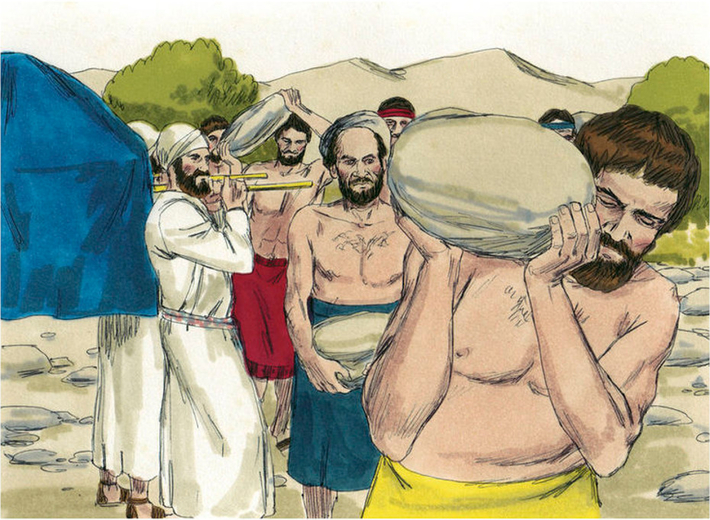
40.21 The Twelve Stones are about anchoring stones: the same anchoring metaphor than with the Two Sandals of Isis
We've already seen the anchoring metaphor in the previous Section about the Isis hauling rope: the Two Sandals of Isis are about the two axle beam holders which were deeply anchored into the top platform of the Grand Gallery (into the two eastern and western rectangular big holes of the platform), hence anchoring the Isis hauling rope in its active operation.
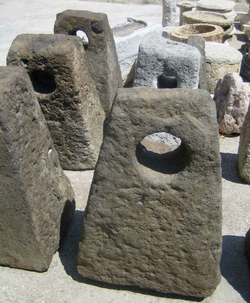
When you are on solid ground, shoes, sandals and feet are what anchoring you into the ground; but if you are not on solid ground, let's say you are in a boat, then shoes, sandals or feet won't be of any help; what you need is an anchor, a real one; and at the time of the ancient World, anchors were made of stone: they were stone anchors; and these stone anchors are what the Twelve Stones, called the stones of the Remembrance, or the Twelve Jordan River Stones were all about.
The same way that the Two Sandals of Isis have been used to describe the necessity of having a very strong anchoring system to hold and secure the Isis rope when hauling the impactor of the Pyramid, the biblical Twelve Stones are about the necessity of the crewmembers of the hauling Beetle to have a very solid grip on the ground: the Bible could have emphasized their sandals, just like it was for Isis, but because the Ark is all about getting into water (just like Noah's Ark), stone anchors had been preferred to sandals.
Stone anchors at the Hellenic Maritime Museum, Piraeus. "Maritime mooring device in the form of a stone, often having a grooved facet, or eye, by which it can be secured to rope".
Photograph by José M. Ciordia: https://commons.wikimedia.org/wiki/Category:Stone_anchors#/media/File:Stone_anchors_-_Hellenic_Maritime_Museum_-_Piraeus.JPG
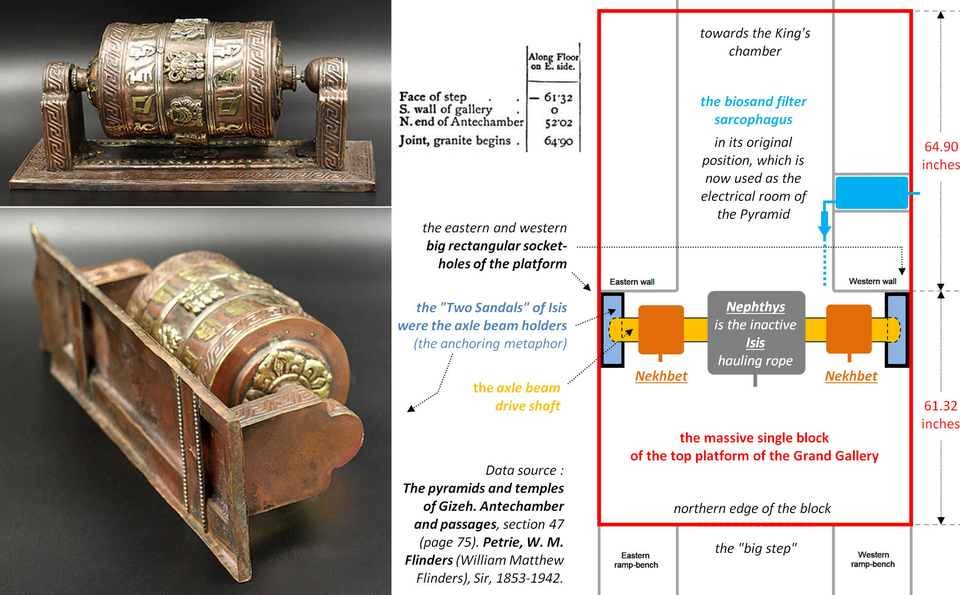
Interestingly, the shape of the above stone anchors have the exact same design as the one of the axle beam holders of the Grand Gallery of the Great Pyramid, and the exact same design as well as the one of some Tibetan prayer wheels (Section 38). Last updated June 20, 2023.
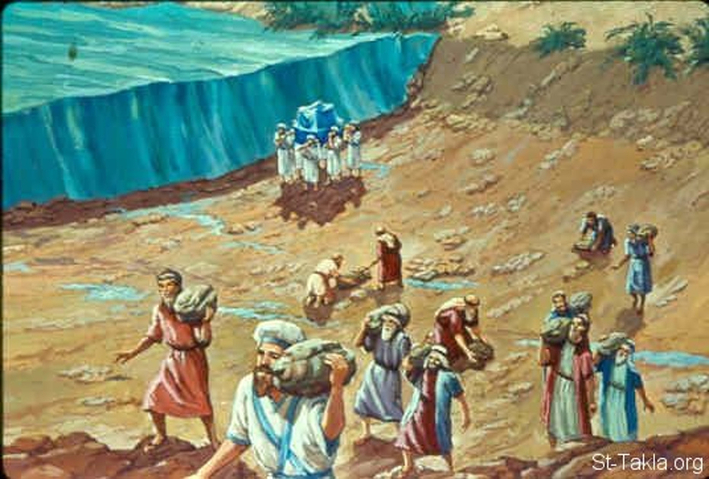
In this image, the numbers of priests carrying the Ark of the Covenant is correct: there were indeed 6 priests carrying the Ark, because there were 6 crewmembers hauling the impactor of the Great Pyramid of Egypt.
Source of the image: https://st-takla.org/bible/commentary/en/ot/matthew-henry/joshua/ch4.html
40.22 The biblical Twelve Stones are the confirmation that there were 6 priests carrying the Ark of the Covenant, just like there were 6 crewmembers hauling the impactor inside the Great Pyramid of Egypt... twelve stones mean twelve feet
In the book of Joshua, it is said that while the priests were carrying the Ark of the Covenant, they arrived at the Jordan River and began to cross it, and at every step they took, the waters of the river stopped, creating a path through which all the Jews crossed. This passage is an echo of the passage of the Red Sea when the Hebrews escaped from Egypt. But this generation had never seen the previous miracle and Joshua wanted to make sure that they did not forget this miracle. When they reached the other shore, Joshua heard a divine voice that asked him to place 12 large stones from the Jordan River in that new land they had arrived on behalf of each of the 12 tribes.
"When all the nation had finished passing over the Jordan, the Lord said to Joshua, “Take twelve men from the people, from each tribe a man, and command them, saying, ‘Take twelve stones from here out of the midst of the Jordan, from the very place where the priests’ feet stood firmly, and bring them over with you and lay them down in the place where you lodge tonight.’ "(Joshua 4.1-3: https://biblia.com/bible/esv/joshua/4/1-3)
We've just seen that the 6 crewmembers of the hauling Beetle were the real meaning of the fact that the Ark of the Covenant circled the wall of Jericho, once a day for 6 consecutive days; and we have here another confirmation that the crewmembers in the active hauling Beetle were really 6: if it is said that the twelve stones were to be taken at the exact location of where the priests had stood their feet, it is simply because they were twelve feet in the first place.
In other words, there were 6 priests carrying the Ark of the Covenant, and there were 6 priests because there were 6 crewmembers hauling the impactor in the Great Pyramid.
The Twelve Stones correspond to the twelve feet of the priest carrying the Ark, and to the 6 crewmembers of the hauling Beetle.
40.23 The second set of Twelve Stones in Joshua 4.9
Everybody knows about the Twelve Stones which were brought from the Jordan river to the shore (the metaphor is about the anchoring of the feet of the 6 priests carrying the Ark of the Covenant, as the reinterpretation of the 6 crewmembers hauling the impactor of the Great Pyramid): "When Joshua and the people of Israel entered the Promised Land, God spoke to Joshua and said, “Choose twelve men from among the people, one from each tribe, and tell them to take up twelve stones from the middle of the Jordan, from right where the priests are standing, and carry them over with you and put them down at the place where you stay tonight” (Joshua 4:2-3)". https://www.christianity.com/wiki/bible/what-is-the-significance-of-the-stones-of-remembrance.html
… but there actually is another set of Twelve Stones, in a very short passage in Joshua, and these stones are brought from the shore towards the bed of the river: "Joshua also set up another pile of twelve stones in the middle of the Jordan, at the place where the priests who carried the Ark of the Covenant were standing. And they are there to this day". Joshua 4.9 — New Living Translation (NLT) https://biblia.com/bible/kjv1900/joshua/4/9
40.24 Is the second set of Twelve Stones in Joshua 4.9 about the girdles and half-girdles of the inclined well?
What it means is that the second set of Twelve Stones appearing in Joshua 4.9 in most probably about the girdle stones of the inclined well: the girdle stones were, so to speak the anchoring stones of the well.
Now the problem is to be sure that there are indeed 12 girdles in the ascending passage, and the problem is that until today, I've mentioned 14 girdles, and I obviously have to explain myself here:
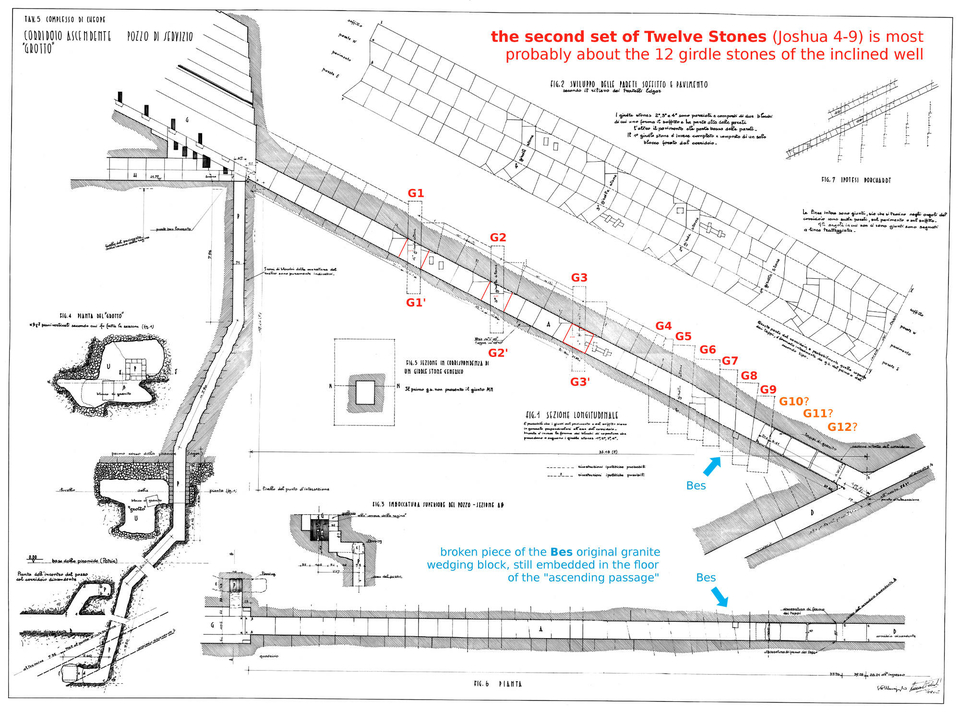
Diagram of the Great Pyramid of Egypt, showing 3 additional girdles below the girdle stone G9: G10, G11 and G12. Each one would have been responsible to host, or accommodate one of the 3 granite plugs after the shut-down procedure of the pyramid.
40.25 The 3 additional girdle stones hypothesis to accommodate the 3 granite plugs
Until today, I've mentioned 14 girdle stones set in the inclined well, and I obviously have to explain myself here, as it was clearly a very lazy work.
I actually copied the hypothesis made on https://www.sickleoftruthblog.com/2017/05/14/the-great-pyramid-part-20/ and its following page; at the time I was only interested in the fact that according to Petrie's study of the ascending passage, everything below the G4 girdle was also built with girdle stones (full or half girdles): I didn't really care how many girdles there were.
Also, I have to admit my drawing of the bottom of the well wasn't very accurate and 14 girdles fit perfectly...
But if you look at the above drawing made by the Italian egyptologist, I'm sorry I didn't get his name, it would rather be 3 girdles that would perfectly fit bellow G9.
And if you think it through, there is kind of a very interesting pattern appearing if you consider the hypothesis that only 3 additional girdles are set below G9: look again at the Italian diagram, and you will see that the space where are supposed to be the additional girdles is actually meant to accommodate the 3 granite plugs.
If there really are 3 girdles below G9, it would mean there is exactly one additional girdle stone for each granite plug. Three additional girdles for the three granite plugs, each girdle "taking care" of one granite block; it does make perfect sense to me.
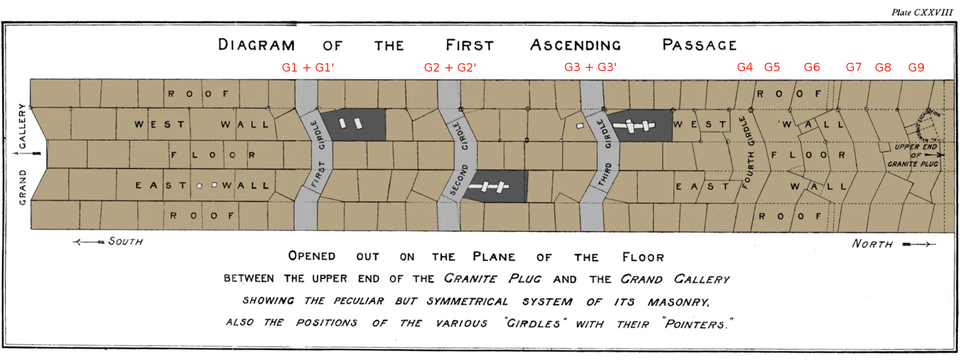
Original drawing and following excerpts are from "Great Pyramid Passages", Volume 1 (1910 edition), plate CX, paragraph ref. 460, page 230; by John and Morton Edgar: https://archive.org/details/GreatPyramidPassagesVol11910Edition/page/n239/mode/2up
Above drawing adapted from: https://www.sickleoftruthblog.com/2017/05/14/the-great-pyramid-part-20/
40.26 The girdle stones according to the Edgar brothers
"466 These three upper Girdles are vertical, and square across from east to west, and are each composed of two stones, an upper and a lower, the upper forming the roof and part of both walls, and the lower the floor and the remainder of the walls, The joints on the walls of the passage between the upper and lower portions of each Girdle are horizontal, but are not opposite each other. In the first and third Girdles which, we have seen, are indicated by pointers on the west wall, the joint on the west is lower than its companion on the east wall ; while in the second Girdle, which is indicated by a pointer on the east wall, the east joint is lower than the west. It would therefore appear that the two stones which form each Girdle are not set horizontally one upon the other from east to west, but at an angle.
467 Those Girdles which lie lower down the passage than the three just described, are all in contact with one another. Though, like the first three, they are vertical, they do not lie square across the passage ; their joint-lines on the floor and roof incline upward diagonally from the east wall to the west wall. Some of these lower Girdles are formed out of a single stone. As will be seen in the drawing (Plate CX), the fourth Girdle is very irregular in shape, its south face being cut to form no less than six distinct joint-lines with the stones above it.
468 The whole of the passage from the fourth Girdle down to the upper end of the Granite Plug is much dilapidated, extensive exfoliation having taken place on walls, roof and floor. Accurate measuring at this part is therefore almost impossible."
40.27 The girdle stones around the granite plug according to Petrie
According to Petrie, it looks like all the stones north of Girdle G9 were also full or half-girdles, and it makes perfect sense as the granite plugs number 2 (the Savior Shock absorber block) and 3 (the Taweret block) were supposed to crash only a few centimeters apart from granite plug number 1 (Beset).
"It has been a favourite idea with some, that two horizontal joints in the passage roof just south of the plugs, were the beginning of a concealed passage: I therefore carefully examined them. They are 6o.5 (or 60.1 second measure) apart vertically, and therefore quite different to the passages of the Pyramid, which are 47 perpendicularly or 52 vertically. Further, there is no possibility of the blocking up of a passage existing there, as the stone of the roof is continuous, all in one with the sides ; the three roof-blocks between the two horizontal joints are all girdle-blocks, either wholly round the passage, or partially so; and the block N, of these is a long one, over 125 inches from E. to W., and continuous into both walls. These vertical girdle-blocks are a most curious feature of this passage (first observed and measured by Mr. Waynman Dixon, C.E.), and occur at intervals of 10 cubits (206.3 to 208.9 inches) in the passage measuring along the slope. All the stones that can be examined round the plugs are partial girdle-blocks, evidently to prevent the plugs forcing the masonry apart, by being wedged into the contracted passage. Many of the stones about the blocks in Mamun's Hole are over 10 or 11 feet long ; the ends are invisible, but probably they are about 15 feet over all."
The pyramids and temples of Gizeh, by Petrie, W. M. Flinders (William Matthew Flinders), Sir, 1853-1942; page 64, "The Inside of the Great Pyramid": https://archive.org/details/cu31924012038927/page/n101/mode/2up
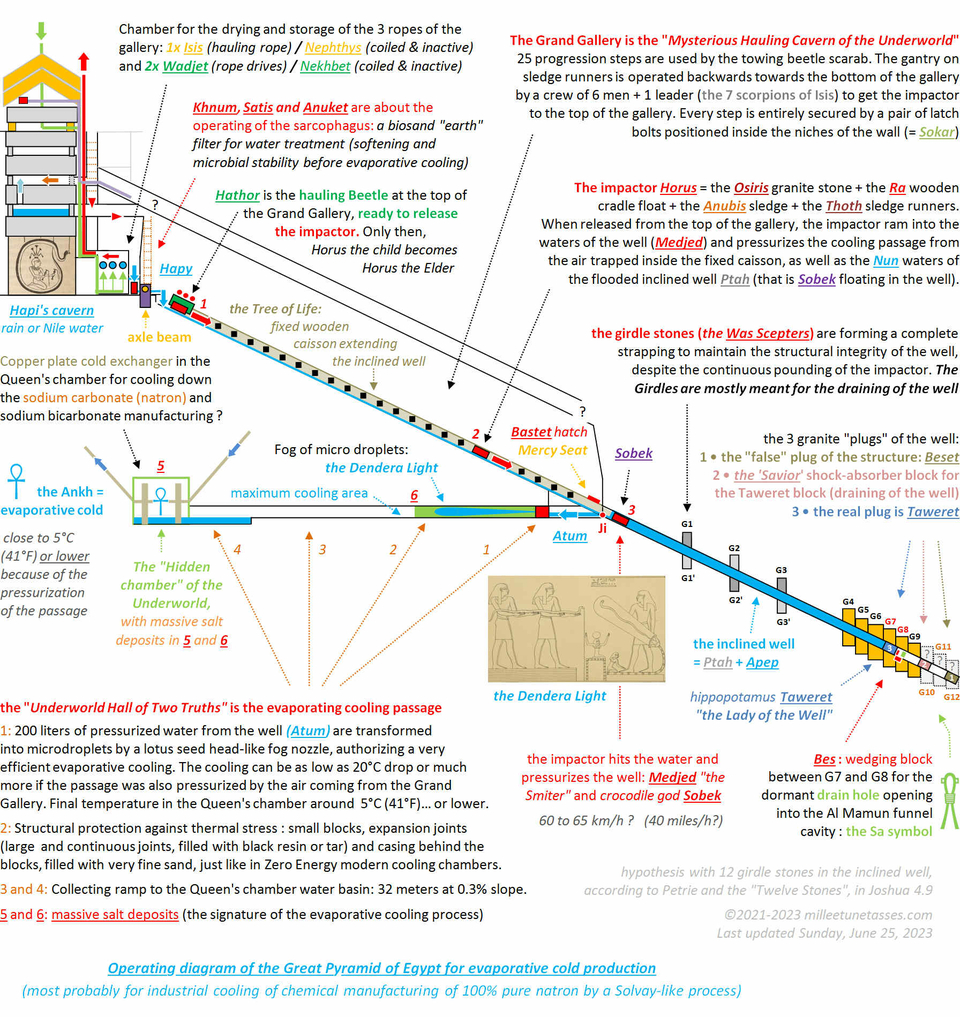
Operation of the Great Pyramid of Egypt for Evaporative Cold Production and chemical manufacturing of natron (pure sodium carbonate) by a Solvay-like process (the natron manufacturing is still hypothetical at that time). Last updated Sunday, June 25, 2023.
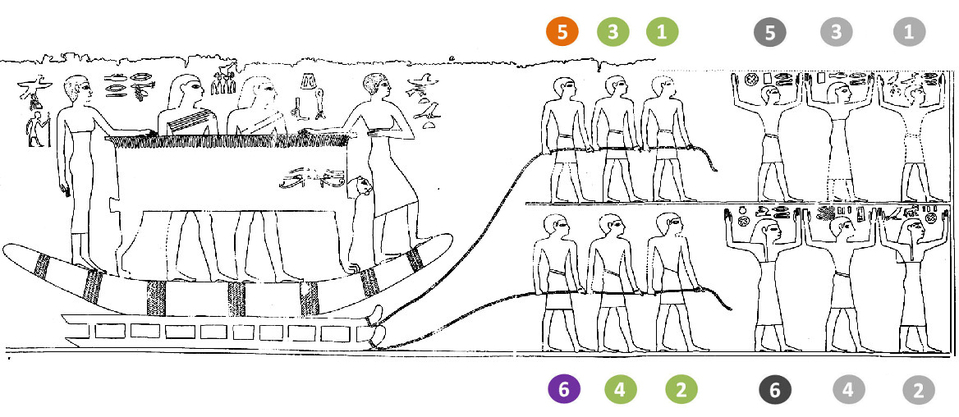
Theban hypogeum tomb of Senet and Antefoker TT60. Image dgd_XIX posted on osiris.net: https://www.osirisnet.net/popupImage.php?img=/tombes/nobles/antefoqer/photo/antefoqer_ndgd_XIX.gif&lang=en&sw=2560&sh=1440
TT60 is the burial place of a woman called Senet. She was related to the ancient Egyptian Vizier Intefiqer (mother or wife). It is one of the earliest burials in the area. Intefiqer was Governor of the city (i.e. Thebes) and Vizier of Senusret I in the 12th Dynasty. Source: https://en.wikipedia.org/wiki/TT60
40.28 The origin of the Ark of the Covenant is the operating cycle of the Great Pyramid's impactor
• the 6 crewmembers of the hauling Beetle: both active (on the left), and inactive (on the right, with raised arms like they were saying "no, sorry, I'm not touching this rope!")
• the 6 priests carrying the Ark of the Covenant (the twelve feet and the Twelve Stones in Joshua 4)
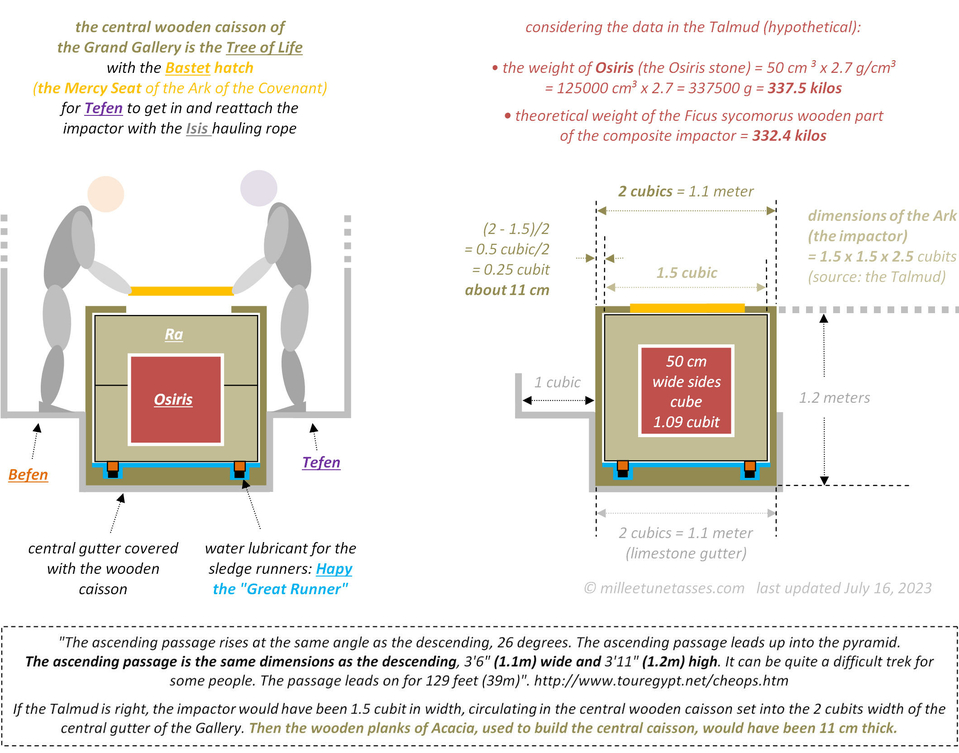
Were the planks used for the central wooden caisson 11 centimeters thick?
40.29 According to the dimensions given by the Talmud, the Ark of the Covenant (the reinterpretation of the impactor of the Great Pyramid of Egypt) would have been able to float
We've already seen in Section 13, that the impactor of the Great Pyramid has most probably been designed with Sycomore wood Ficus sycomorus, and considering the data known from the Talmud about the combined Tablets of Stone, forming a perfect cube of 50 centimeters wide sides, and the dimensions of the Ark of the Covenant itself, 1.5 x 1.5 x 2.5 cubits (approximately 131 × 79 × 79 cm or 52 × 31 × 31 inches), we can start to find some interesting numbers:
• Weight of the Tablets of Stone (the Osiris stone): with a density of the granite stone of 2.7 g/cm 3, we have: (50 cm) 3 x 2.7 g/cm 3= 125000 cm 3 x 2.7 = 337500 g = 337.5 kilos
• Weight of a full wooden impactor: with the density of the Ficus sycomorus wood of 0.48 g/cm3, we have: 131x79x79x0.48 g/cm3 = 392434 g = 392.4 kilos
"The wood density [of Ficus sycomorus] is low and its specific gravity is 0.48 (CSIR, 1996): https://www.cabidigitallibrary.org/doi/10.1079/cabicompendium.24184
• Weight of the Osiris stone if in Ficus sycomorus wood: 50x50x50x0.48=60000 g = 60.0 kilos
• Weight of the wooden part of the composite impactor = (392.4-60) = 332.4 kilos
• Weight of the wooden and composite impactor = (392.4-60=332.4)+337.5 = 669.9 kilos
Interesting data to note:
• Part of the weight because of the Osiris stone: 337.5/669.9 = 50.38%
• Part of the weight of the impactor because of the wooden vessel (Ra) = 332.4/669.9 = 49.62%
• Specific density of the impactor = 0.82
669.9 kilos / (131x79x79=817571 cm3=0.817 m3) = 819.95 kilos/m3.
This data has to be compared with the approximative 997 kilos/m3 of water.
In other words the Ark of the Covenant would have been able to float.
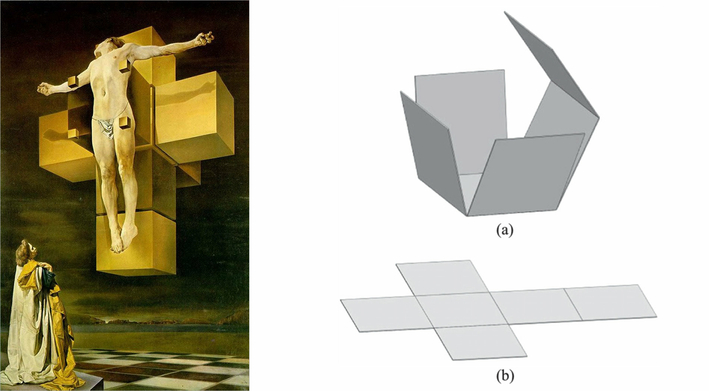
Salvador Dalí, Crucifixion (Corpus Hypercubus), 1954. " Dalí utilized his theory of "nuclear mysticism," a fusion of Catholicism, mathematics, and science, to create this unusual interpretation of Christ’s crucifixion". Excerpt from the Metropolitan Museum of Art: https://www.metmuseum.org/art/collection/search/488880?imgNo=0&tabName=object-information
Image of the painting at: https://upload.wikimedia.org/wikipedia/en/0/09/Dali_Crucifixion_hypercube.jpg
Hollow cube made of thin-layer sheets in two operation modes: (a) during opening (unfolding); and fully opened (b), by Mohsen Daghooghi: https://www.researchgate.net/figure/Hollow-cube-made-of-thin-layer-sheets-in-two-operation-modes-a-during-opening_fig9_306029539
40.31 [The Osiris stone being a perfect cube] • The Christian Cross could originate in the "unfolded" Osiris stone (very hypothetical)
Of course, the problem is to know if we can rely on these data, and if the Osiris stone of the Great Pyramid really was a cube of granite, with 50 centimeters-wide sides; it is indeed possible that this hypothetical cube suggested in the Talmud could only be another scientific metaphor: if everything about the ancient Egyptian religion and its monotheistic reinterpretations (Judaism, Christianity and Islam) are all founded in scientific knowledge and technological accomplishments, the "cube thing" could simply be kind of a scientific proclamation, as the cube is with the circle the perfect mathematical and geometrical illustration of that knowledge.
Anyway, it is interesting to note that if you "unfold" the faces of a cube, the Christian Cross appears... So, whether the real original Osiris stone of the impactor of the Great Pyramid was indeed in a cubic form or not, it seems that it could be the origin of the Christian Cross (very hypothetical): ancient Egyptians would have glorified the Osiris stone in the Benben stone at the top of the Obelisks, and Christians would have "unfold" this stone to create the Cross so that Jesus would be lifted to the heavens, at the same time that the stone would rise in the Grand Gallery (again, this is very hypothetical and it would need a complete study of the Christian religion to confirm or invalid this particular point).
The Pyramids of the Cold version 2 (May 2023 - March 2024)
Summary of the study and Table of Contents
Part A: The evaporative cooling process
Section 1 • The horizontal evaporative cooling passage layout
Section 2 • The Dendera Light and the creation of the fog of microdroplets by the fog nozzle
Section 3 • The water cycle glorifying metaphors: Geb, Shu, Nut, Tefnut
Section 4 • The theorization of the evaporative cooling process by Akhenaten and Nefertiti
Section 5 • The theorization of the evaporative cooling process in the Weighing of the Heart
Part B • The inclined well of the Great Pyramid of Giza
Section 6 • The inclined well layout and the girdle stones
Section 7 • The Taweret "Lady of the Well" temporary sealing granite plug of the well
Section 8 • The Bes temporary wedging block immobilizing Taweret
Section 9 • The draining of the well
Section 10 • The Great Serpent Apep and the snake water metaphors
Section 11 • The Was scepter and the control over "snakes"
Section 12 • The beating Heart of the Great Pyramid
Part C • The composite impactor of the Great Pyramid (Horus, Ra, Osiris, Medjed, Sobek...)
Section 13 • The wooden and stone composite design of the impactor: Ra and Osiris
Section 14 • The endlessly immersed Osiris stone and the seed metaphor
Section 15 • The Anubis sledge and the bobsled mask
Section 16 • The sledge runners of the impactor: Thoth
Section 17 • Medjed: the smiter nobody can ever see
Section 18 • The Apis bull and the ramming impactor's metaphors
Section 19 • The crocodile god Sobek impactor (more or less) floating in the waters of the well
Section 20 • The Obelisk and the Benben stone rising from water
Part D • The Grand Gallery's of the Great Pyramid of Giza
Section 21 • The Sacred "sloping paths" of the "oval-shaped cavern of the act of Hauling"
Section 22 • The central wooden caisson of the Gallery: Sekhmet and the Triad of Memphis
Section 23 • The hauling ropes of the Grand Gallery: Isis, Nephthys, Hatmehit, Wadjet and Nekhbet
Section 24 • The hauling Beetle and the Seven Scorpions of Isis
Section 25 • The Great Cow goddess Hathor and the operating cycle of the hauling Beetle
Section 26 • The 10 operating phases of the Grand Gallery
Section 27 • The guide to the Afterlife for the smart traveler and the canopic jars
Section 28 • The scarab amulet glorifications of the hauling Beetle
Part E • The very large and roughly finished sarcophagus of the Great Pyramid
Section 29 • The biosand filter sarcophagus of the Great Pyramid
Section 30 • The Elephantine Triad deification of the biosand filter of the Great Pyramid
Section 31 • The Great Pyramid's operating flat roof and the water supply issue
Part F • Chemical manufacturing and industrial cooling before the Great Pyramid
Section 32 • The Serdab and the "Refreshment of the Gods" Step Pyramid of Djoser
Section 33 • Sneferu's Red Pyramid and the accumulated ammonia
Section 34 • The Disc of Sabu and the Solvay process for pure natron manufacturing
Part G • The tremendous impact of the Great Pyramid on the whole ancient world
Section 35 • The hidden secrets of the Hermetica Emerald Tablet (around 1600 C.E.)
Section 36 • Thor and the magical Hammer in the Great Hall of Bilskirnir
Section 37 • The Churning of the waters of the Ocean of Milk (Hindu mythology)
Section 38 • The Tibetan prayer wheels and the Grand Gallery's operation
Section 39 and Conclusion • The cooling water of spitting Kebechet
Part H • Epilogue
Section 40 • The smiting Ark of the Covenant and the Ten Commandments
Section 41 • The 293 kilograms windlass Staff of Moses and Aaron... and the First Plague of Egypt: water turning into blood
Section 42 • Ezekiel's Four Egyptian pulley "Wheels within the Wheels" and the four angel ropes
Section 43 • David, Saul, two giant Goliaths, five little stones, an aeolian harp... and a weaver's beam
Section 44 • The holy water fonts and the biosand filter
Part I • The magicians of the Great Pyramid of Giza
Section 45 • The Legend of Khufu and the "magician" polymath Imhotep
Section 46 • The two magical eyes of Isis and the brilliant but painful flame of her twin sister's braids
Poster un commentaire

